How-To Geek
How to use speaker notes in powerpoint.
If you're worried about forgetting important points during your presentation, jot down some speaker notes. Here's how to prepare and use them.

Quick Links
Add speaker notes in powerpoint, use speaker notes during a powerpoint presentation.
Adding speaker notes to a PowerPoint presentation provides reference material for the speaker when they're presenting a slideshow, allowing them to stay on track without forgetting key message points. Here’s how to add and use speaker notes.
To add speaker notes in PowerPoint, you’ll first need to be in the Normal view. If you’re not already there, you can switch to Normal view by going to the “View” tab and then selecting “Normal” in the “Presentation Views” group.
Next, in the pane on left, select the slide where you'd like to add speaker notes.
Next, click the “Notes” button at the bottom of the window.
A small box reading “Tap to Add Notes” will appear beneath the slide. For Mac users, this will say “Click to Add Notes.”
Now, simply type the speaker notes for that slide. Repeat this process for each slide you'd like to add notes to.
There are two ways to use speaker notes during a presentation: by presenting on a secondary monitor or by printing out the speaker notes .
Using a Secondary Monitor
It’s safe to assume that most presentations will be presented on a secondary monitor. If this is the case for you, there’s not a whole lot you really need to do.
Related: How to Add an Extra Monitor to Your Laptop
The first thing you need to do is change the view to Slide Show. You can do this by selecting the Slide Show icon at the bottom-right corner of the window.
In this view, the audience will see only the slides as you’re going through the presentation. However, on your primary monitor, you’ll see the current slide, a preview of the upcoming slide, and your speaker notes for the current slide.
This is a convenient way to have a virtual copy of the speaker notes while you’re giving a presentation, but it never hurts to have a hard copy.
Printing the Speaker Notes
To print the speaker notes of your presentation, first select the “File” tab in the Ribbon.
Related: How to Print Multiple PowerPoint Slides to Each Piece of Paper
In the pane on left, select the “Print" button.
In the “Settings” group, select the option that says “Full Page Slides.”
A drop-down menu will appear. Here, select “Notes Pages” in the “Print Layout” group.
Finally, click “Print.”
You’ll now have a physical copy of your speaker notes.
- Meta Quest 4
- Google Pixel 9
- Google Pixel 8a
- Apple Vision Pro 2
- Nintendo Switch 2
- Samsung Galaxy Ring
- Yellowstone Season 6
- Recall an Email in Outlook
- Stranger Things Season 5
How to add notes to your Microsoft PowerPoint slides
When you present a slideshow, it’s likely that you have more to say than what displays on the slides. You may want to expand on the text you’ve included, or if the slide only contains visuals, explain them further.
Add speaker notes to a slide in PowerPoint
Hide notes while editing a slideshow, view speaker notes during a slideshow.
Luckily, Microsoft PowerPoint provides a built-in feature for speaker notes. This allows you to add notes to each slide and then see them in Presenter View when you start the show.
What You Need
Microsoft PowerPoint
Open your PowerPoint presentation and select the first slide where you want to add notes.
Step 1: Go to the View tab and choose either Normal or Outline View . This allows you to see your slide along with the note you plan to add.
If you’re wondering how to add a note in PowerPoint without changing the view, the short answer is: You can’t. But if you prefer not to use Normal or Outline View, you can check out the Notes Page view in the same section of the ribbon.
While still technically a “view,” this displays your slide and a text box for your note as a printed page, as shown below.
Step 2: Display the Notes panel below the slide if it’s not visible using one of the following:
- Click the Notes button in the Status Bar at the bottom.
- Move your cursor to the bottom of the window. When you see the two-sided arrow, drag up until the panel displays.
- Best Microsoft Office deals: Get Word, PowerPoint, and Excel for free
- How to convert Google Slides to PDF
- How to buy Microsoft Office: all methods, explained
Step 3: When the panel is empty, you’ll see “Click to Add Notes” within it. Place your cursor in the box and type your note.
Step 4: You can apply simple formatting to your note using the tools on the Home tab or in the floating toolbar. This is handy if you want to add bullet points or emphasize the font with bold, italics, or an underline.
Step 5: If you have a lengthy note within the panel, you’ll see a scrollbar appear on the right so that you can move down and see the entire note. You can also drag up on the panel to enlarge it.
If you want your slide in full view as you're assembling or editing your slideshow, you can hide the presenter notes. This does not delete them; it merely moves the notes panel out of view.
Do one of the following to hide your notes:
- Drag the notes panel downward until it no longer displays.
When it’s time to present your slideshow, you can use Presenter View to see your speaker notes. This allows you to view the notes for each slide on your monitor while presenting the slideshow on another. Your audience will not see your notes.
Step 1: Go to the Slide Show tab. On Windows, check the box for Use Presenter View in the Monitors section of the ribbon. On Mac, click the Presenter View button in the Start Slide Show section.
If you’ve already started the slideshow, you can still turn on Presenter View. Click the Three Dots in the Presenter Toolbar and choose Show Presenter View (Windows) or Use Presenter View (Mac).
Step 2: You’ll then see your notes display on the right side of the screen, with your slide on the left. As you advance each slide, the notes will display accordingly.
Step 3: The text for your note wraps automatically to the next line, and you have a scrollbar to move through those lengthy notes.
To adjust the font size for the notes, use the buttons below the notes panel.
Whether you want to add notes to PowerPoint to talk through your slideshow or simply as references while you assemble your slides, be sure to take advantage of this built-in feature.
For additional ways to work in Microsoft PowerPoint, check out how A.I. can help you create your slideshows .
Editors' Recommendations
- How to keep your Microsoft Teams status active
- How to add audio or video to Google Slides
- How to change your background in Microsoft Teams
- How to embed a YouTube video in PowerPoint
- How to convert a PowerPoint to Google Slides
- How-To Guides

Few communication applications are as versatile as Microsoft Teams. Along with allowing you to send quick messages to teammates or launch a video chat, the software is fully integrated with Office 365 so you can optimize its performance. One of its most useful features, however, is the ability to create a new team. This lets you group people together so they can chat about certain projects or goals without spamming everyone in your organization.
Knowing how to make a new team and how to properly organize teams makes it easy for a company to enhance productivity and streamline communication. When used effectively, Microsoft Teams is useful for both in-office and remote workers, ensuring everyone stays on the same page regardless of location.
PowerPoint makes it easy to give a great presentation thanks to intuitive software that lets anyone craft an eye-catching deck. What's even better, however, is the option to use Presenter View. This lets you leave notes for yourself that can be viewed on your computer screen while everyone else is only seeing your presentation.
Do you have any clue how much power your PC consumes when you’re playing video games? Or how about when it’s just sitting idly? Whether you’re trying to figure out how to cut down on energy costs, or simply want to know how much toil your PC endures when running Abode Creative Suite, you’ll want to learn how to measure your PC’s power draw.
Fortunately, there are several different tools you can use to monitor this important statistic. Some are built right into your operating system, while others will require a separate download. You can also purchase certain external devices to keep tabs on your desktop’s energy output.
Home Blog PowerPoint Tutorials How to Add Speaker Notes in PowerPoint? A Quick Guide with Video Tutorials
How to Add Speaker Notes in PowerPoint? A Quick Guide with Video Tutorials
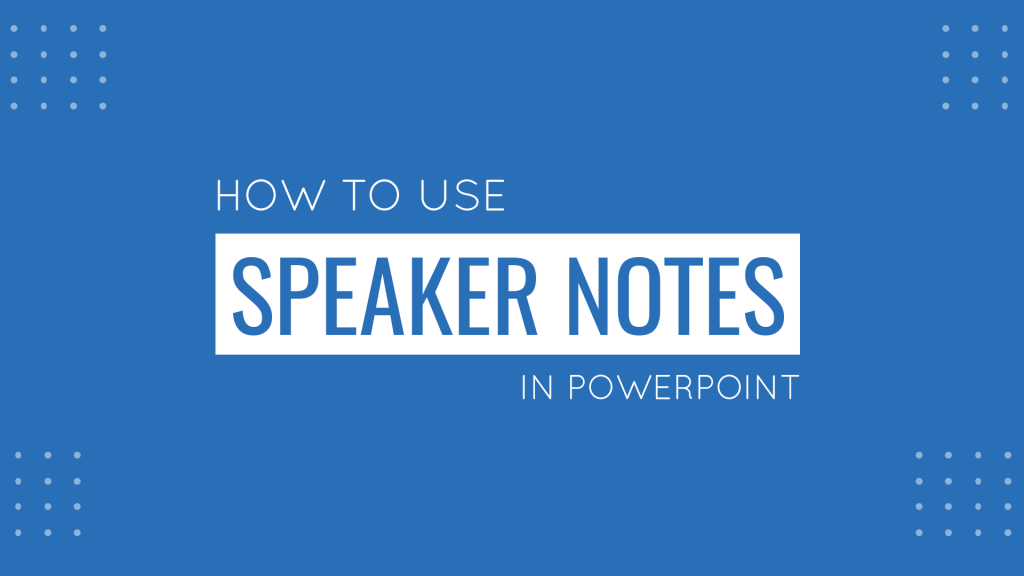
It can be hard to remember all the information you intend to discuss during a presentation. To avoid text-heavy slides and missing out on important information, some presenters use notes or flashcards. A more elegant method of presenting your slides is to use speaker notes in PowerPoint .
What are Speaker Notes in PowerPoint?
Speaker notes in PowerPoint are hidden notes in your PowerPoint slides that can be added to help you remember bits of information. Speaker notes are only visible to the presenter and can also be printed with slides for reference. You can use the printed version of speaker notes for yourself or the audience for later reading.
Speaker notes are visible to the presenter during Presenter View, which enables viewing the slide and notes side by side. This enables the presenter to show the audience only the slides, as he/she presents with the aid of notes visible on their screen.
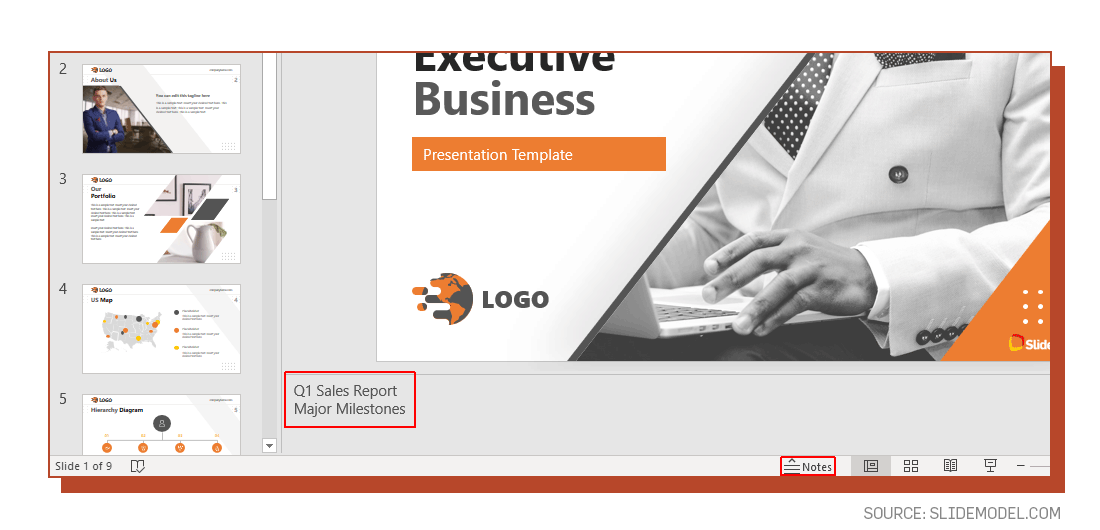
What are the Benefits of using Speaker Notes?
Speaker notes can have a number of benefits and can enable you to not only appear more confident as you present but to also better organize your slides.
1. Speaker Notes Help Avoid Text-Heavy Slides
One of the benefits of using speaker notes is that you can avoid adding too much text to your slides and insert related points as Speaker Notes. This can provide your audience with a clutter-free view of your slides, as you use the notes to ensure you remember all the important bits of information during the presentation.
2. Speaker Notes can Help Replace Paper Notes
Flashcards or paper notes can look inelegant and can cause confusion if they get mixed up. Many presenters end up stuttering or scrambling their notes during a presentation due to this very problem. Presenters can avoid this hassle by simply using speaker notes in PowerPoint.
3. Speaker Notes can be Helpful in Recalling Information
Speaker notes can be helpful in remembering important information when you find it difficult to recall the information. In such a case the notes can be added as a precaution so that you can quickly recall that important piece of information when you have a hard time recalling something.
4. Speaker Notes can Enable You to Stay on Point
With a presentation with a bit of text and an elaborate theme, a presenter can easily lose focus. To stay on point, you can add speaker notes to set the right sequence for you to follow as you present your slides.
5. Speaker Notes can Help you Appear More Confident
The audience appreciates a presenter when he/she has the confidence to look them in the eye and speak their heart out. Presenters who scramble for notes or keep looking at their flashcards can appear less confident.
How to Add Notes to PowerPoint?
Adding speaker notes in PowerPoint is very simple. In this short tutorial we explain how to add notes to PowerPoint depending on your preferred platform.
How to Add Speaker Notes to PowerPoint for Windows?
Step 1. Select the Slide you want to add speaker notes to.
Step 2. Select Notes in the bottom right section of your screen.
Step 3. Add the notes you want below the PowerPoint slide.
How to Add Speaker Notes to PowerPoint for macOS?
How to Add Speaker Notes to PowerPoint for web?
PowerPoint in the web version lets you create Speaker Notes but does not let you view them when you are presenting.
Which option is used to create speaker notes in the PowerPoint Slide?
On the View tab of the ribbon, in the Show group, select Notes.
The pane appears across the bottom portion of the PowerPoint window, with the cursor blinking, ready for you to begin typing.
Also, you can add speaker notes in PowerPoint by clicking the Notes option at the bottom of the slide to open the notes pane. The option can be used to open or hide the pane anytime.
Expand Notes Pane: To expand the notes pane, hover your mouse to reveal the vertical scroll bar and drag to adjust the size of the pane according to need.
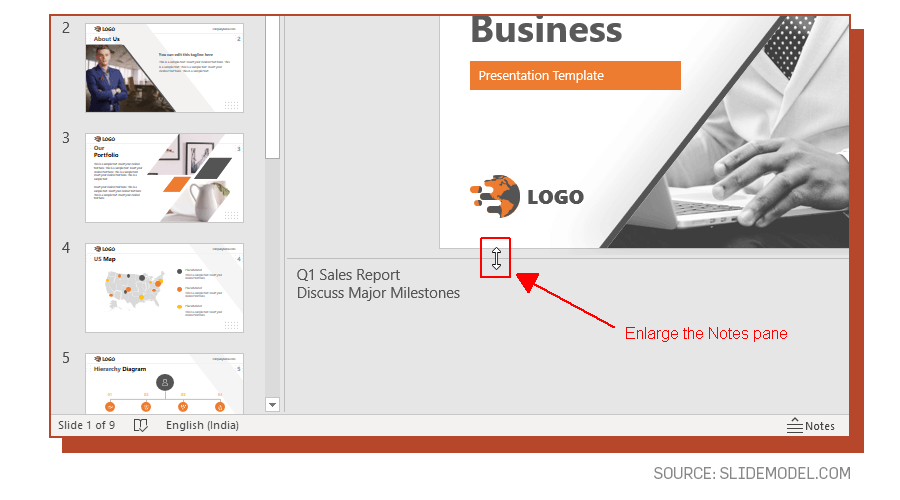
How to View Speaker Notes in PowerPoint while Presenting?
How to present with speaker notes? Now that you know how to add notes to PowerPoint, you can use this feature to deliver your presentation while visualizing the speaker notes as a presenter. Here we will see how to view speaker notes in PowerPoint in Presenter View.
Enable Presenter View: You can view Speaker Notes in PowerPoint in Presenter View . To make sure this option is enabled in PowerPoint, go to the Slide Show tab, and check Use Presenter View .
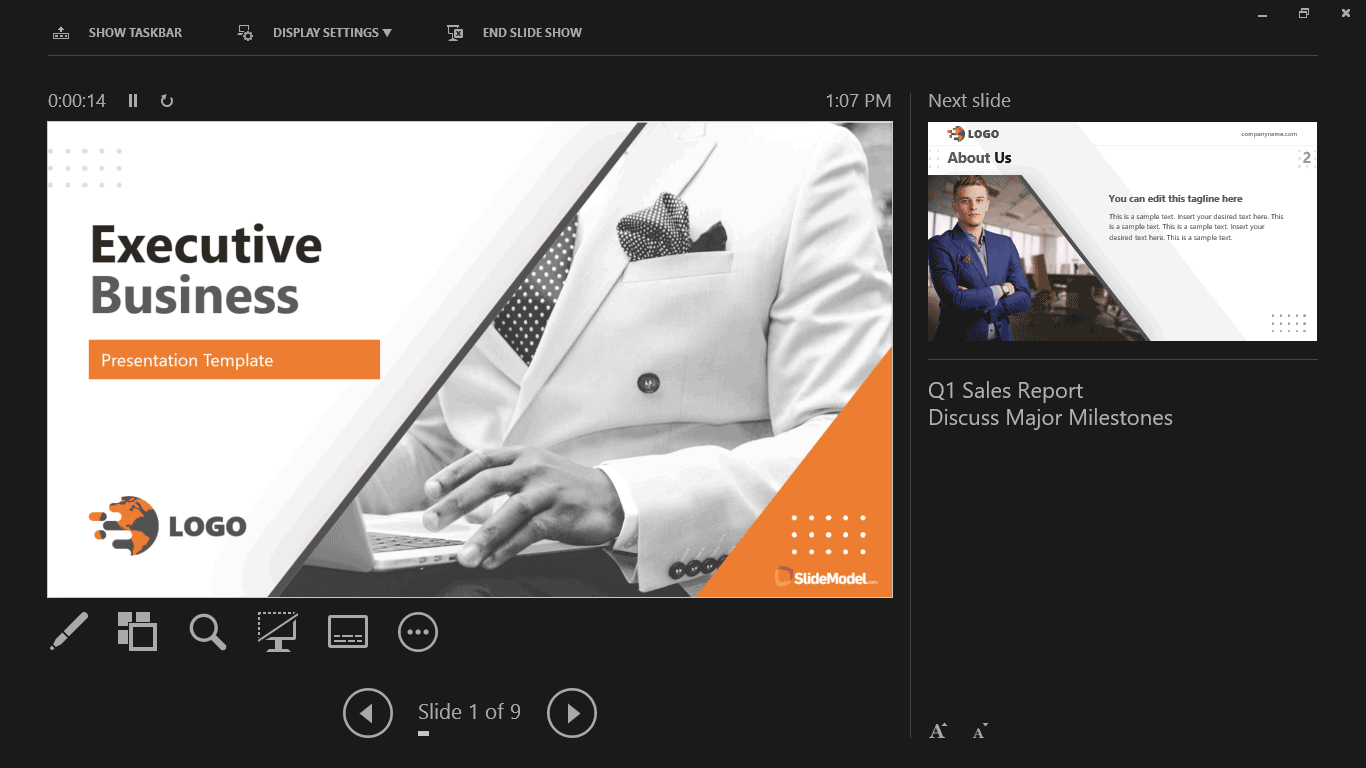
Select Monitor Settings: From the Slide Show tab, you can also select which monitor you want your presentation to appear on. This can help you ensure that the monitor selected for the speaker notes does not swap with the monitor screen intended for the audience. Usually, setting the monitor settings to Automatic should automatically show speaker notes on your laptop and the view with only your slides to the audience. However, checking these settings beforehand can help you avoid swapping the screens.

Adjust Text Size for Notes: When in Presenter View, you can also expand or reduce the size of the text using the buttons on the bottom right corner of the screen.
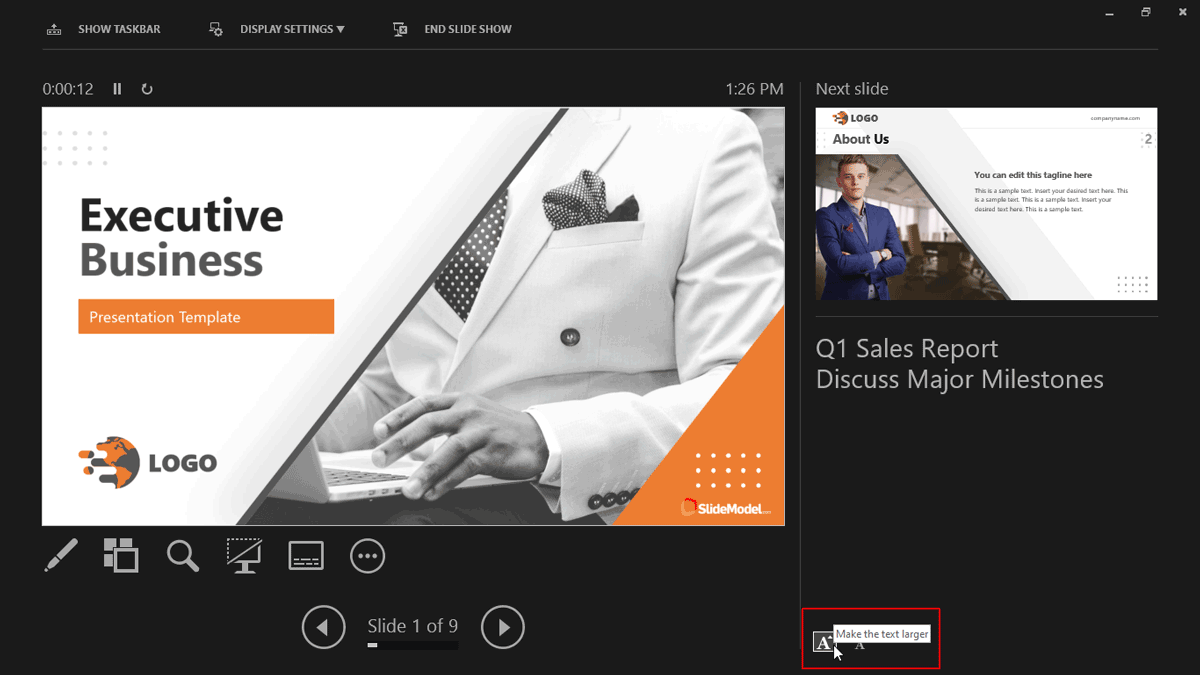
Navigate Slides: The arrow keys enable you to move between slides in Presenter View.
Annotate Slides: You can enable the Pen tool or highlighter to annotate slides during your presentation or use the Laser Pointer to focus on parts of your slide using an onscreen laser tool. These options are available via the Pen and Laser Pointer Tools option at the bottom of the Presenter View menu.
Zoom Slides: You can zoom in to a specific slide by selecting the Zoom option and then clicking on a specific section of the slide that you intend to zoom in.
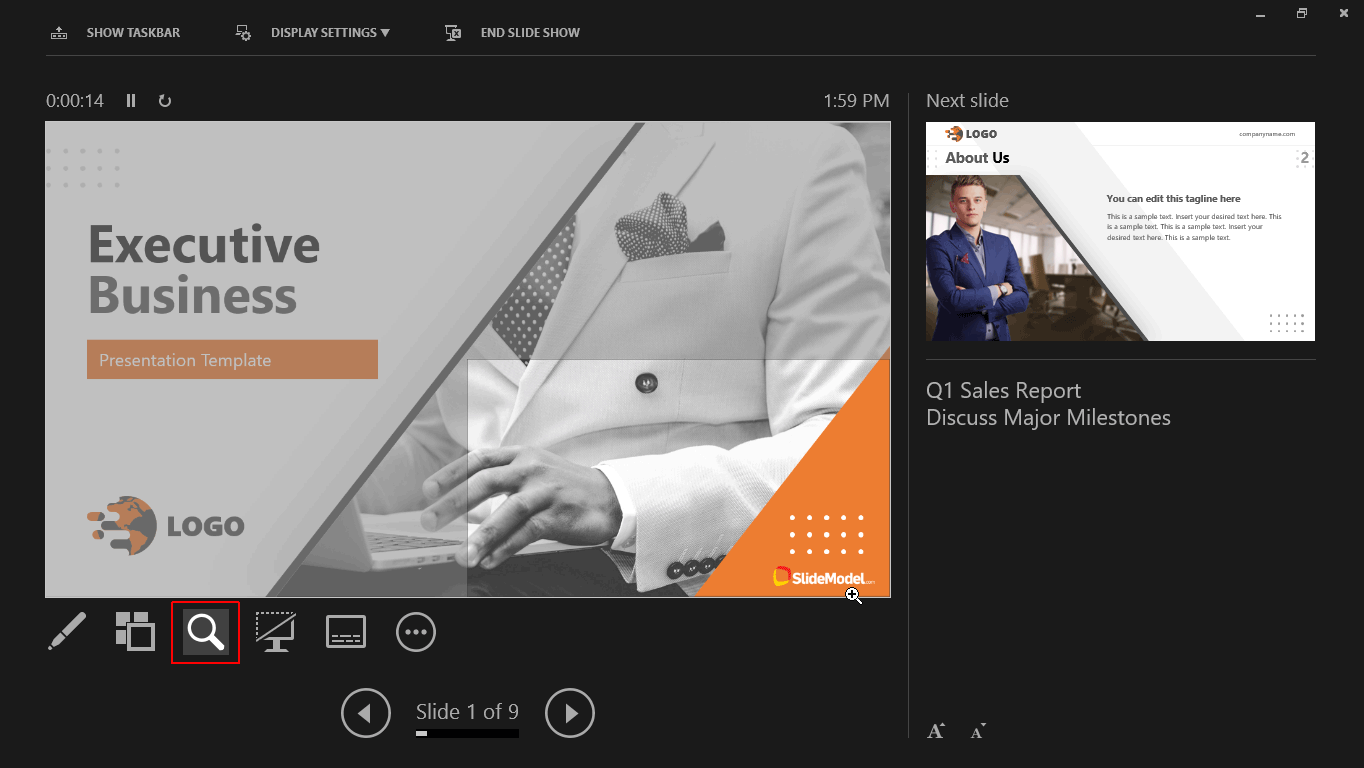
Switch to a Specific Slide: You can also jump to a specific slide via the See all slides option. This can help you instantly change your slide in a single click, without moving back and forth to find it.
Black or Unblack Slideshow: You can hide or unhide a slide by using the Black/Unblack Slideshow option.
Toggle Subtitles: In a previous post, we showed you how to enable subtitles and captions in PowerPoint . The subtitle button in Presenter View enables you to toggle the subtitles on or off.
Hide Presenter View: To turn off Presenter View anytime, you can select Hide Presenter View from the More slideshow options button.
How to print PowerPoint with Speaker Notes?
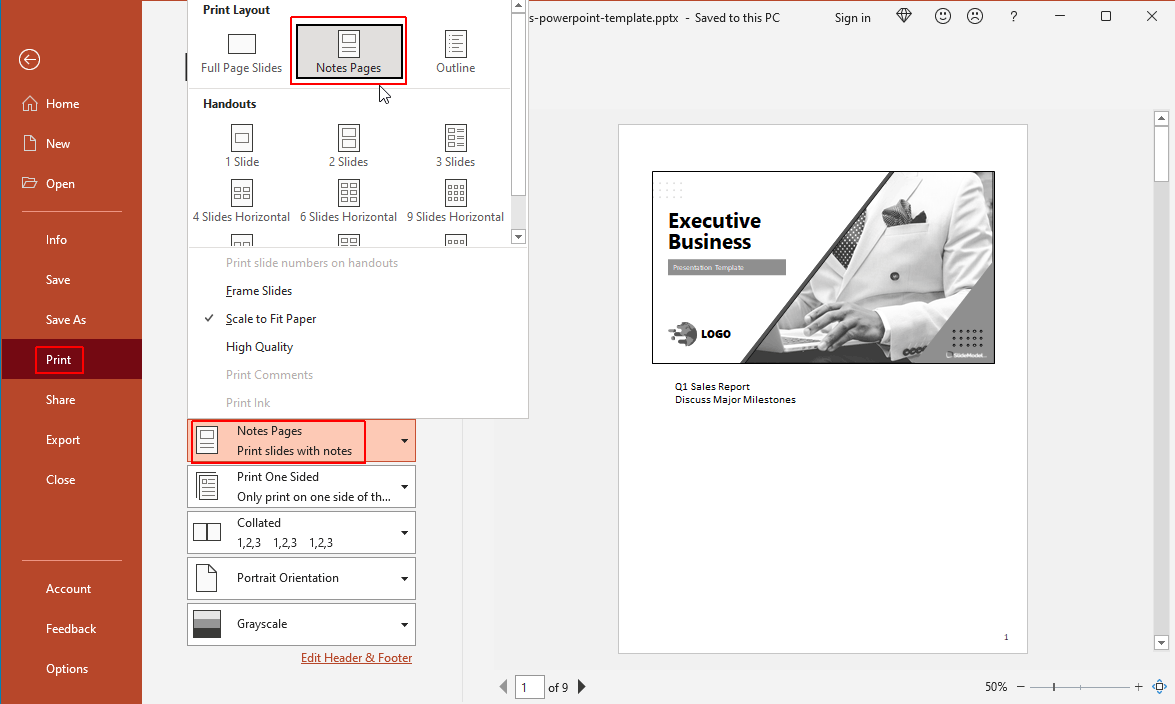
Print PowerPoint with Speaker Notes is very simple:
Printing Speaker Notes with Slide Thumbnails: You can print speaker notes directly in PowerPoint by going to File -> Print -> Settings -> Notes Pages.
Printing Speaker notes without Slide Thumbnails: If you would like to print the notes without thumbnails, go to View – > Notes Pages, delete the thumbnails for each slide, and then print your notes via File -> Print -> Settings -> Notes Pages.
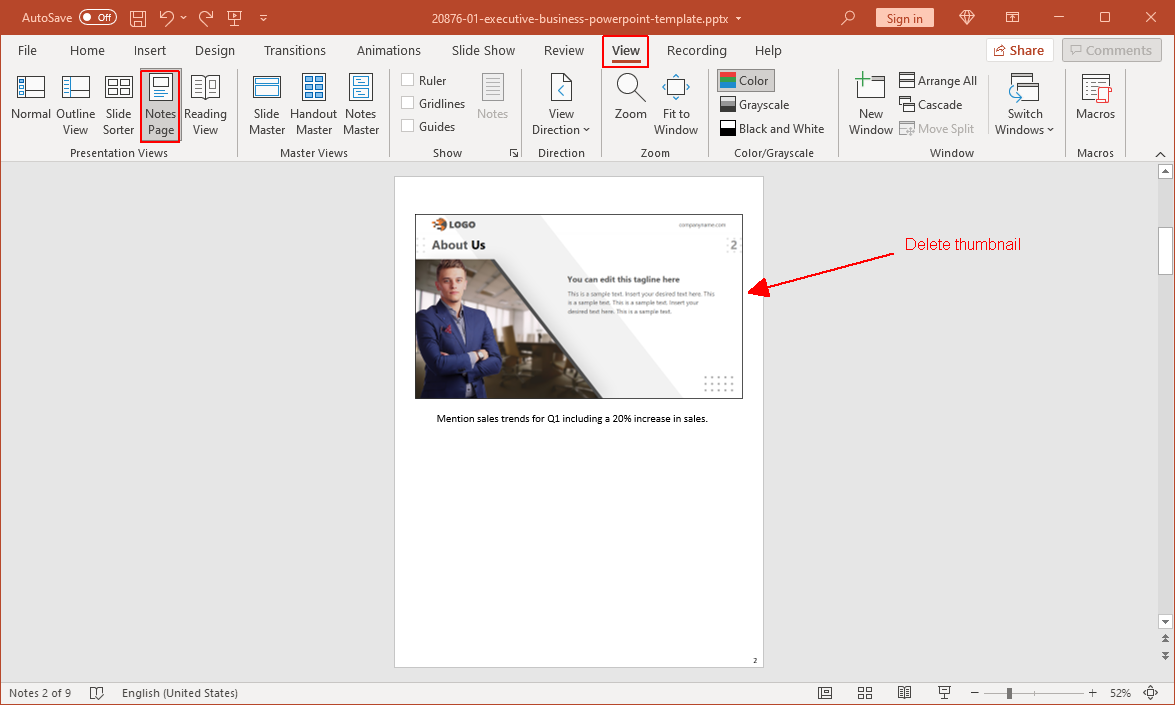
Creating and Printing Handouts using Speaker Notes in PowerPoint
You can create handouts from your speaker notes by exporting them to a Microsoft Word file or printing them directly from PowerPoint.
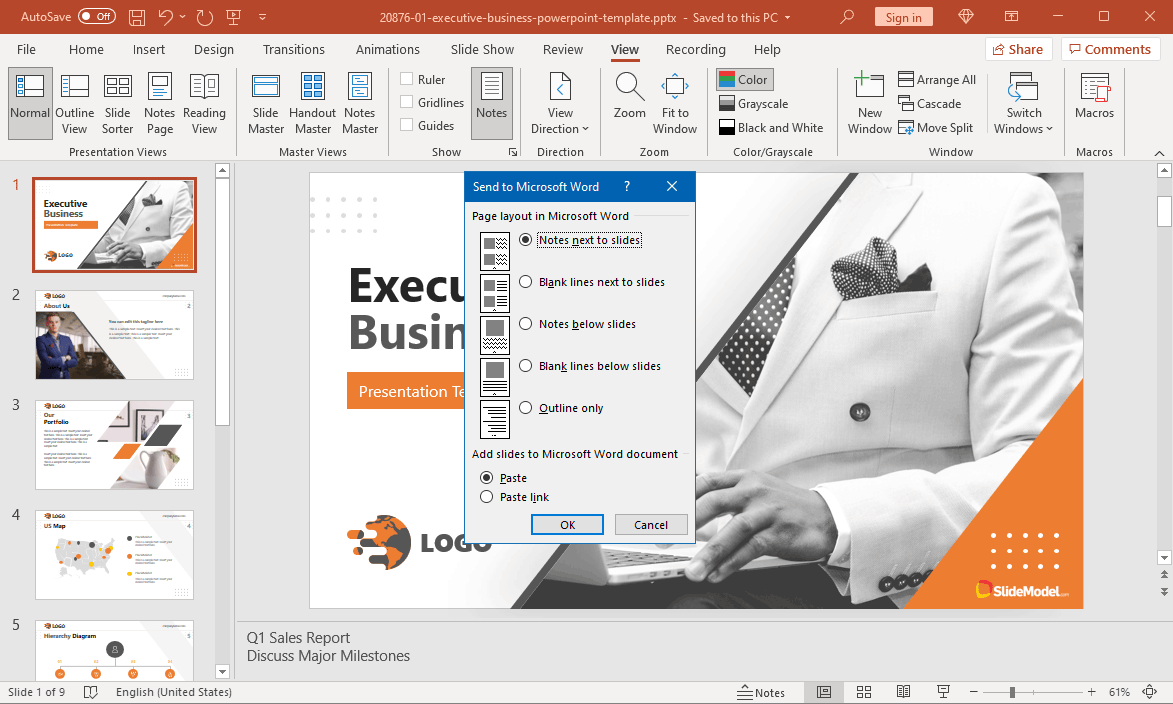
Export Handouts to Word
To export your handouts to Word, go to File -> Export -> Create Handouts .
This will provide you with the option to select whether you would like to export notes next to slides or export blank lines next to slides, notes below slides, blank lines below slides, or the outline only.
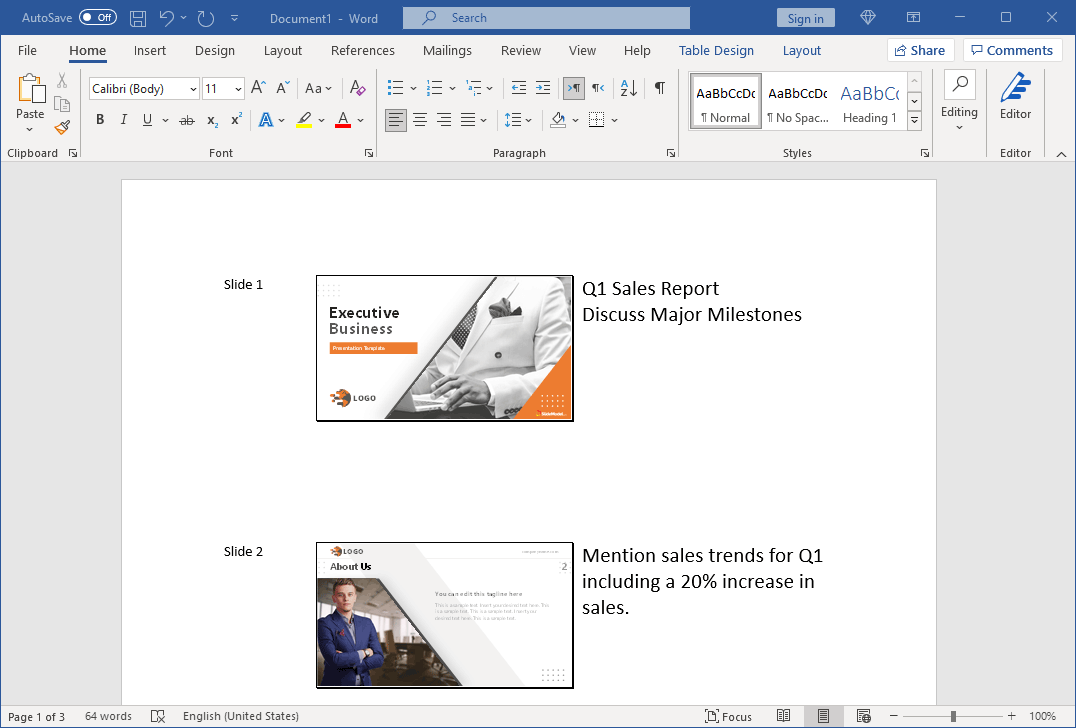
Below is an example of handouts exported to Microsoft Word from PowerPoint. You can print these handouts from Word anytime via File -> Print.
Final Words
Speaker notes in PowerPoint can help presenters create uncluttered slides and present information without worrying about messy paper notes or missing out information because of an oversight. Speaker notes provide much needed support to cater to the needs of the modern presenter, with the added advantage of printing or providing handouts to the audience after the presentation, such as citations and links for further reading.
If it’s your first time presenting with speaker notes in PowerPoint, you should try to acquaint yourself with the necessary settings and features of speaker notes to avoid getting confused when using them for the first time. Sometimes, monitor settings can flip, especially amidst an online presentation via Zoom or other video calling apps. To prevent that from happening, you can have a mock call with a colleague to make sure speaker notes aren’t visible. To do that, you can rehearse your presentation by adjusting your screen share view while hiding speaker notes.
Discover our step-by-step guide on how to make a presentation .
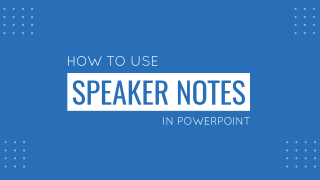
Like this article? Please share
Presentation Ideas, Presentation Tips, Speaker Notes, View Presentation Filed under PowerPoint Tutorials
Related Articles

Filed under Google Slides Tutorials • May 3rd, 2024
How to Work with Google Slides Version History
Go back to previous changes or check who edited your presentation. Learn how to work with Google Slides Version History here.

Filed under Design , Presentation Ideas • May 1st, 2024
The Power of Mind Map Note Taking for Presenters
Add a new tool to your repertoire of presentation skills by mastering the art of mind map note taking. An ideal process to facilitate content retention.

Filed under Google Slides Tutorials • April 29th, 2024
Best Google Slides Add-Ons
Optimize your Google Slides experience by installing the best Google Slides add-ons available in the market. Full list with photos.
Leave a Reply
- Slidesgo School
- PowerPoint Tutorials
How to Add Speaker Notes in PowerPoint

Speaker notes can be very useful to highlight the ideas you want to talk about during your presentation. In this new Slidesgo School tutorial, you’ll learn how to enter speaker notes , how to activate the Presenter View and how to use its tools .
Adding Speaker Notes
Presenting with speaker notes, using the presenter view.
- Open your presentation in PowerPoint.
- At the bottom of the screen there’s a text field with the message “Click to add notes”. The text that you enter here will be visible for you during your presentation, but not for your audience.
- If you can’t see this text field, click View → Notes. You can also click the Notes button located at the bottom of the screen.
- To display the speaker notes, you must have two screens: one for the presentation and another for the notes.
- Go to the Slide Show tab.
- In the Monitors group, check “Use Presenter View”. If you have two screens, this box will be automatically checked. Your presentation will be displayed on the secondary screen and the Presenter View will be on the main screen. You can change this by selecting a different option from the Monitor drop-down list.
- Click the Slideshow button located at the bottom of the screen. As an alternative, you can click From Beginning, on the Slide Show tab, or just press F5. Your presentation will start in Presenter View.
There are different options at your disposal during your presentation. Some of them are exclusive of this view, so let’s talk about this.
- Current slide and Next slide: The current slide and the next one will always be visible for you.
- Slide number: At the bottom of the screen, click the left arrow to go back to the previous slide, or click the right arrow to move on to the next one.
- Pen and laser pointer Tools: You can activate the pen to draw on the slides, or the laser pointer to highlight the contents of the slide.
- See all slides: If you click this button, you’ll see all the slides of your presentation.
- Zoom into the slides: You can zoom into any part of the screen.
- Black or unblack slide show: This allows you to hide or unhide the current slide.
- Toggle subtitles: If you click this button, the subtitles will appear on the screen. This button is only available in Office 365 and newer versions.
- Zoom: Under the speaker notes you’ll find two buttons that allow you to increase or decrease the size of the text.
- More slide show options: These include hiding the slide, changing the position of the subtitles and disabling the speaker notes.
- At the top of the screen you’ll find three buttons that allow you to access the taskbar, change the main screen or end the presentation.
Do you find this article useful?
Related tutorials.

How to Use the Presenter View in Google Slides
Google Slides, like PowerPoint, has different presentation modes that can come in handy when you’re presenting and you want your slideshow to look smooth. Whether you’re looking for slides only, speaker notes or the Q&A feature, in this new Google Slides tutorial, you’ll learn about these and their respective settings. Ready? Then let’s explore the presenter view!

How to Download Google Slides Templates
When preparing a presentation, many people start panicking because they realize how much time it will take to edit each and every slide. Creating them from scratch, filling them in, looking for pictures, moving the elements...How stressful! But there is a solution that saves you a lot of time. We're sure that you've browsed the internet for templates, or basically, pre-established designs and elements, that can be downloaded for free and can be edited to your liking. Are we right? Then, we have some good news for you!

Discover our collection of printable templates
With the advance of technology, printing has become something that is no longer a necessity. Smartphones have made the paper format less and less frequent, but there are still certain cases in which having physical resources is much more convenient. Whether it's for taking notes, handing out assignments, making worksheets or handing out business cards or invitations, it's necessary to print your customized designs.From now on, in every Slidesgo printable presentation that you download, you will find the instructions for printing on the third slide. Depending on the style, colors or format of each presentation, we will tell you if you can...

How to Add Superscript and Subscript in Google Slides
Let’s take the most famous formula: E=mc^2, Einstein’s relativity equation. It wouldn’t be the same if it was E=mc2, right? Okay, yes, some people write it like that because it’s very famous and it won’t be misunderstood. But technically… It can! This is where the sophistication of superscript or subscript enters the room! Do you know how to write them in equations, copyright brands or even footnotes in your presentations? Let’s figure out how.

Free Online Microsoft Training
Free tips and tricks for using Microsoft Office and Windows
How to add speaker notes in PowerPoint
- By Belinda Anderson
- 9 November 2016
- Updated: 6 December 2023
- No Comments

When creating a presentation it can be daunting trying to remember what needs to be said and when. You may also encounter the odd occasion when a presentation will be shared between multiple presenters. There can be confusion in knowing what to say and when. These cases are perfect examples of when you can add speaker notes to your PowerPoint presentation allowing all involved to see what needs to be discussed during each slide.
If you are new to presenting or plan to share your presentation with others you will find the use of speaker notes very effective. PowerPoint even provides a special Presenter View which lets you see your slides and your speaker notes whilst those viewing your presentation will only see the slide information – no notes.
Today I will show you how to add speaker notes to each slide within your presentation. You can then utilise the Presenter View features within Microsoft PowerPoint to deliver your presentation.
Add speaker notes to your presentation
The first step in this process is to add speaker notes to each individual slide within your presentation. To add speaker notes to individual slides, follow these steps:
- Open Microsoft PowerPoint .
- From the Start screen , select Open Other Presentation , or select a presentation from the Recent list .
- Ensure that Slide 1 is currently displayed. This is generally your opening title slide.
- If you cannot see the Notes area displayed underneath the slide area, click the Notes button located in the Status bar:
- Place your cursor in the notes area at the bottom of the screen where it says Click to add notes :
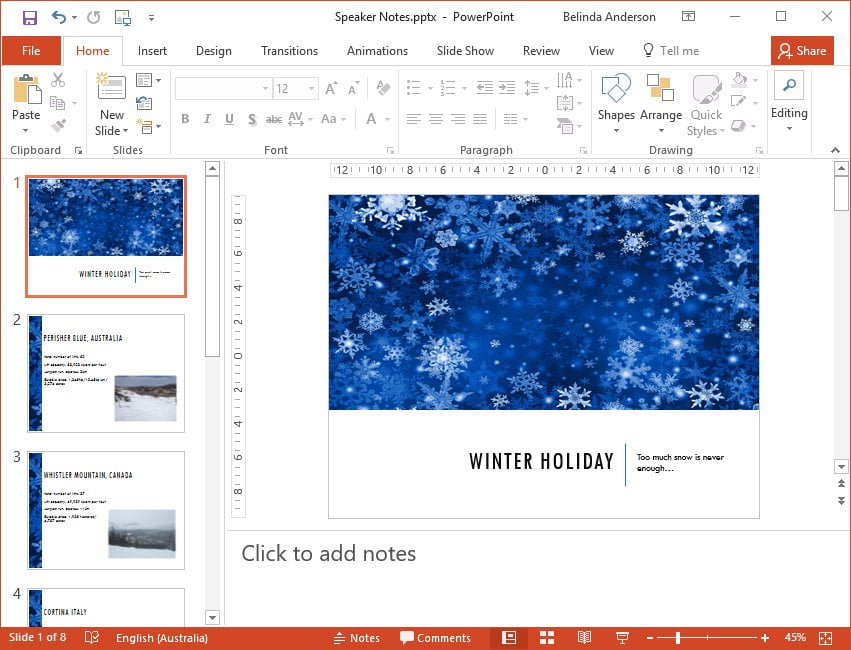
- Directly type any notes for Slide 1 into the notes area. For this exercise write a few lines on how you might introduce the presentation to the audience or possibly give them a brief introduction about yourself.
- Speaker notes should be brief bullet points or key information you want to discuss. I generally don’t recommend writing word-for-word exactly what you want to say as your presentation should feel natural and not scripted.
- You can use all font formatting options to make your notes easier to read, including the use of bullet or numbered lists.
- Select Slide 2 from the navigation pane.
- You will notice the notes area is empty.
- Repeat the process and enter some notes for Slide 2.
- Repeat this process until all slides contain speaker notes.
- You have now entered speaker notes.
View Speaker Notes
To view the speaker notes page, follow these steps:
- Click View > Notes Page .
- The presentation will now be displayed in notes view. This gives you a snapshot of the slide and displays the notes at the bottom of the page:
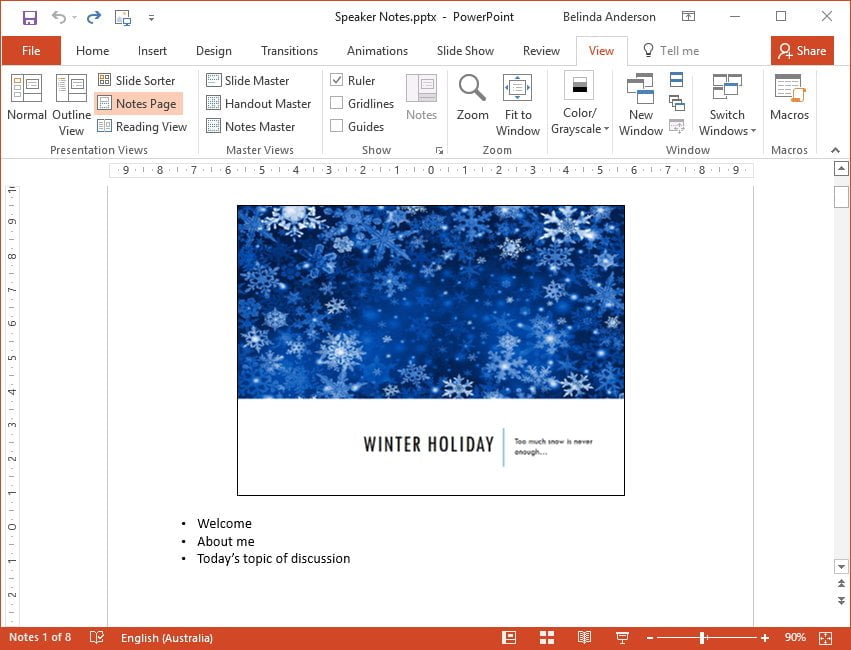
- Use the up and down scroll bar to move between each slide.
- Select View > Normal to return to the normal view.
View speaker notes during a presentation
Microsoft PowerPoint allows you to run a presentation and view your speaker notes at the same time. This provides guidance whilst the audience can only see the slides being projected. This features is referred to as Presenter view.
Presenter view works on any operating system that supports multiple displays, such as Microsoft Windows 7 or higher. It allows you to run your presentation from one monitor and let the audience view it on another monitor or a data projector.
NOTE : The computer must have multiple monitor capability— check with the manufacturer if you are unsure. Usually, desktop computers require two video cards in order to have multiple monitor capability; laptops often have the capability built in.
For the most part, you just need to connect the monitor and/or data projector and PowerPoint automatically sets it up. If you are creating your presentation on a computer with a single monitor and you want to use Presenter view, you can still do this. I always recommend testing Presenter View on the computer you will be presented with prior to your live presentation. This will ensure you can iron out any technical issues you may encounter prior and also makes for a less stressful start to your presentation.
To enable Presenter View, follow these steps:
- Select Slide Show > Set Up Slide Show .
- Under the Multiple monitors heading select the checkbox for Use Presenter View .
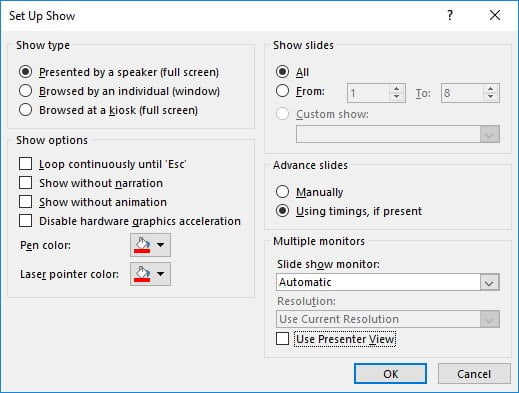
- Press F5 to view the slide show in Presenter View.
- Microsoft PowerPoint will now display your slide show in Presenter View:
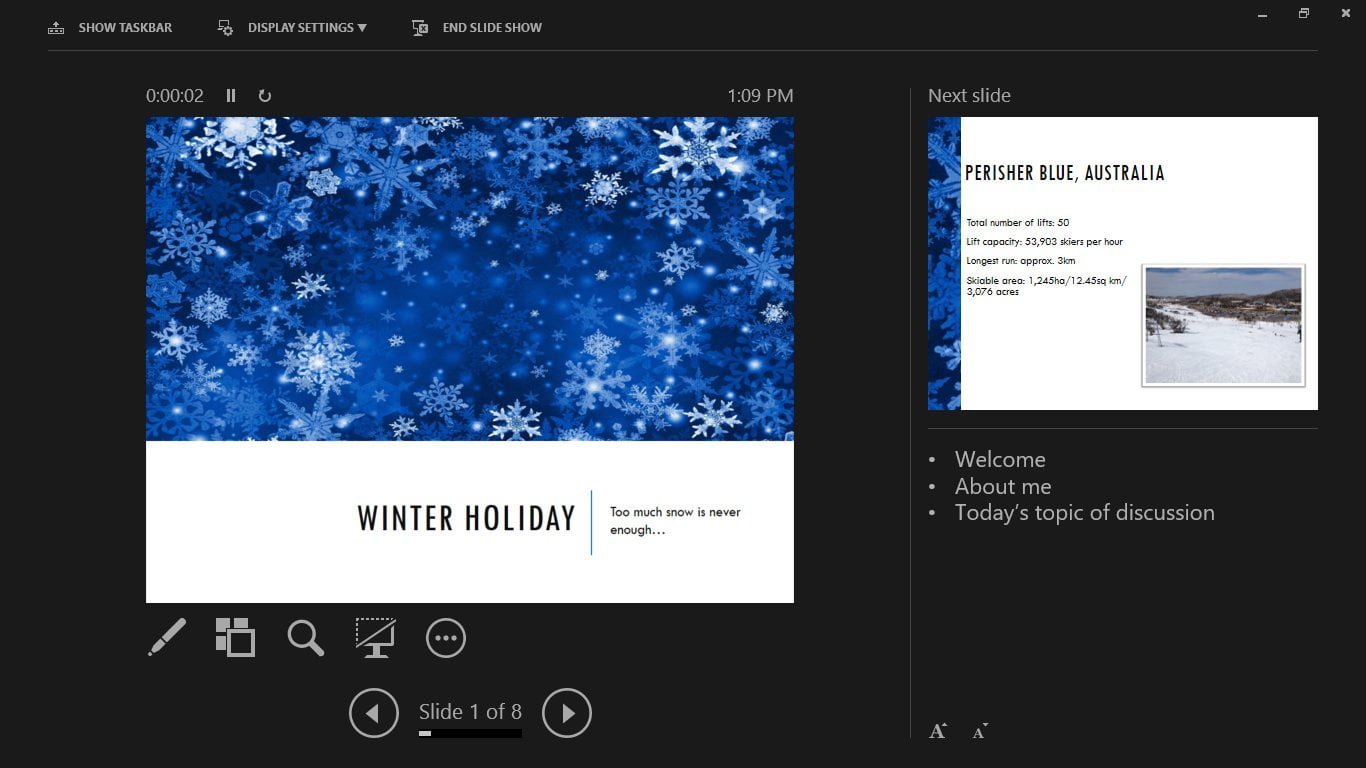
- Meanwhile, if a data project is plugged into your computer, you will automatically see Presenter View displayed on your computer screen.
- If you are using PowerPoint on a computer with a single monitor, launch your presentation and then click the More button and choose Show Presenter View :
Congratulations, you have now added speaker notes to your presentation and displayed it using Presenter View. I highly recommend checking out my post on how to use the Rehearse Timings in PowerPoint along with my 10 tips for highly effective presentations .
- PowerPoint , Slide show , Slides , Speaker Notes
- Microsoft PowerPoint
Leave a Reply Cancel reply
Your email address will not be published. Required fields are marked *
Please enter an answer in digits: 18 + 17 =
This site uses Akismet to reduce spam. Learn how your comment data is processed .
Recent Posts

- Microsoft Excel (37)
- Microsoft Forms (9)
- Microsoft OneNote (10)
- Microsoft Outlook (33)
- Microsoft PowerPoint (31)
- Microsoft Sway (8)
- Microsoft Teams (10)
- Microsoft Windows (23)
- Microsoft Word (31)
Critical PowerPoint Shortcuts – Claim Your FREE Training Module and Get Your Time Back!

How to Add Speaker Notes in PowerPoint
- PowerPoint Tutorials
- Shortcuts & Hacks
- April 8, 2019
In this article, you will learn the ins and outs of how to add speaker notes in PowerPoint. This includes printing, presenting, deleting, and formatting your speaker notes so that your handouts look professional.
If you are brand new to adding notes to your PowerPoint presentations, there are three common ways professionals use speaker notes in PowerPoint.

#1. Presenter View: Use your speaker notes as prompts during your presentation. This is the most common use case for adding speaker notes in PowerPoint. You present your slide on a monitor, and you have your main points bulleted out in the Presenter View of PowerPoint.
#2. Normal View: Use your notes as reference documentation for your slides. Instead of listing out the main points for your slides, some professionals use the Notes Pane to capture where their information came from. In this case, you never present or print your speaker notes, you simply keep the links or references to your materials in the Notes Pane.
#3. Notes Page View: use your notes as the final client deliverable like a Word document. The Notes Page View displays your slide at the top of the page and all your speaker notes below it, detailing your comments, recommendations, or action steps like a Word document. While the Notes Page View is NOT as easy to use as Microsoft Word, the fact that the notes stay with each PowerPoint slide makes this very convenient.
How to add Speaker Notes in PowerPoint
There are two different places where you can type your speaker notes in PowerPoint. You can either type them in the Notes Pane at the bottom of your PowerPoint Window, your you can type them in the Notes Page view.
Which of these two views is better? It depends on what level of formatting you want to see your speaker notes in.
The main difference between using these two views when working on your speaker notes is the level of formatting that is displayed. The Notes Pane only displays plain text formatting, whereas the Notes Page View displays all formatting just like Microsoft Word.
Notes added in either view are both viewable and editable in the other view. So, you can flip back and forth between the views depending on what you are doing.
Note: You can only add text as your speaker notes in PowerPoint. You cannot add pictures, charts, tables, etc. Any picture, chart, or graphic you want to reference in your notes must remain on your slide.
#1. The Notes Pane in the Normal View
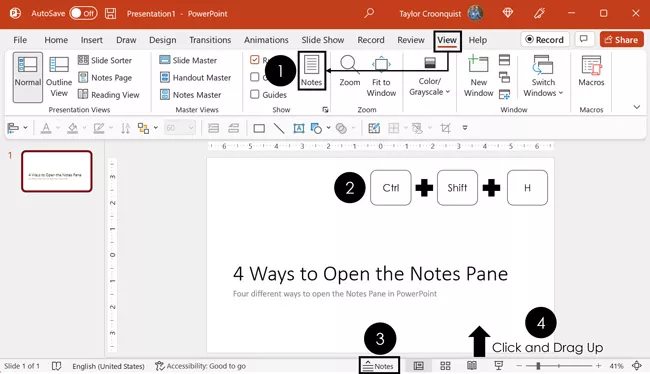
#2. The Notes Page View
The other way you can add and edit your speaker notes in PowerPoint is using the Notes Page View. The advantage of this view is it displays all your text formatting including font size and font color.
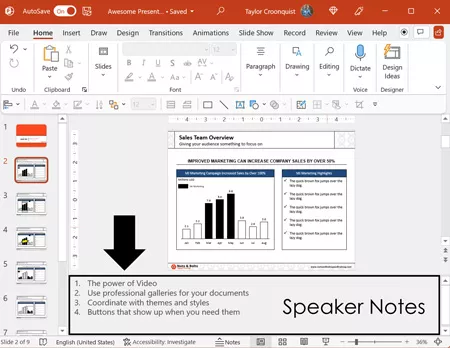
There are four different ways you can open the Notes Pane to add your notes in PowerPoint listed below (and referenced in the picture above).
- Navigate to the View tab and click the Notes command.
- Hit Ctrl+Shift+H on your keyboard to open the Notes Pane.
- Click the Notes command at the bottom of your PowerPoint workspace.
- With your mouse, click and drag the Notes Pane up from the bottom of the PowerPoint workspace.
Regardless of how you open the Notes Pane, once it is open, you can directly type or edit your speaker notes into it. As you will see in the formatting section below, the Notes Pane only displays plain text formatting like bold, italics, numbered lists, bulleted lists, etc.

To add or edit your speaker notes using the Notes Page view in PowerPoint, simply:
- Navigate to the View tab
- Select the Notes Page view
- Click into the input box to type or edit your notes
Note: If you type a lot of text in this view, your notes will run off the bottom of the page. You do not have to worry about losing any of these notes. Any runoff notes will properly display in the Notes Pane and will print properly on the correct number of pages as needed.
Formatting Speaker Notes in PowerPoint
You can apply formatting to your notes in both the Notes Pane and the Notes Page view. That said, not all your formatting properly displays in the Notes Pane .
For example, in the picture below, the red font color I applied in the Notes Pane only displays in the Notes Page view. In this way, only the Notes Page view fully displays all the formatting that has been applied to your speaker notes, so make sure to check this view before you print your notes.
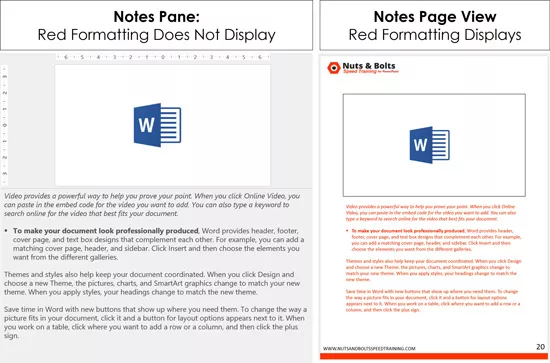
The Notes Pane and the Presenter View only display simple formatting like bold, italics, underlines, bulleted lists, etc. On top of that, these views do not display Font Size. Instead, they only display a zoom level. If you zoom in or out within the Notes Pane or the Presenter View , your Font Size appears to change, but it is only the zoom level changing, not your Font Size.
If you need to see all the formatting applied to your speaker notes in PowerPoint before you print them, the best place to do that is the Notes Page view. See section above for opening the Notes Page view in PowerPoint.
How to remove all your speaker notes at once
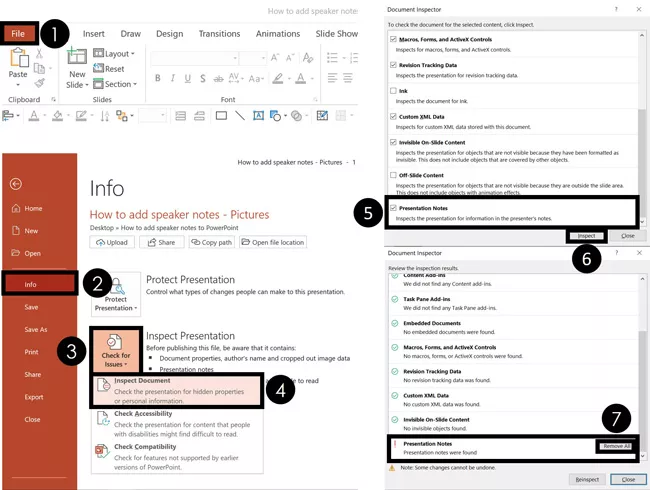
You can remove all your speaker notes (known in PowerPoint as Presentation Notes) before you share your presentation with someone using the Inspect Document feature . To remove all your notes at once, simply:
- Navigate to the File menu
- Click the Info
- Open the Check for Issues drop down
- Select Inspect document (select Yes if a dialog box opens)
- Make sure the Presentation Notes option is selected
- Click Inspect
- For Presentation notes, select Remove all
After you select Remove All , all your speaker notes will be removed from your presentation. Just keep in mind that once you remove them, you cannot undo this selection.
So, if you want to keep a copy of your notes, you should first save a copy of your presentation.
How to view your speaker notes in Presenter View
Regardless of how you add your speaker notes to PowerPoint, you can view them in the Presenter View of PowerPoint. You can access this view using shortcuts, or you can set it to run automatically if you are connected to a second monitor.

To set up the Presenter View to run automatically when you connect to an overhead projector or monitor, simply.
1. Navigate to the Slide Show tab 2. Put a checkmark next to Use Presenter View
After selecting Presenter View, the next time you hook up to a monitor or overhead projector and run your presentation, your slides will display on the screen and the Presenter view will display on your computer.
You can alternatively launch the Presenter View at any time using the Alt+Shift+F5 shortcut. To expand your knowledge and learn a variety of ways to present a PowerPoint slideshow (including hidden shortcuts), read our guide here .
How to print your PowerPoint with notes as handouts
To print your PowerPoint speaker notes as handouts, simply:
- Select File then Print (or hit Ctrl+P)
- Change the slides dropdown to Notes Pages
- Click Print
If you want to print your speaker notes next to your slide, you’ll need to first export your slides to Microsoft Word (discussed below).
To expand your knowledge and learn other nuances and tips for printing PowerPoint with notes, read our guide here .
To learn how to print your presentation with multiples per page as handouts, read our guide here .
Below are some important things to keep in mind as you start to print your PowerPoint notes as handouts.
1. Slide Numbers are different than page numbers
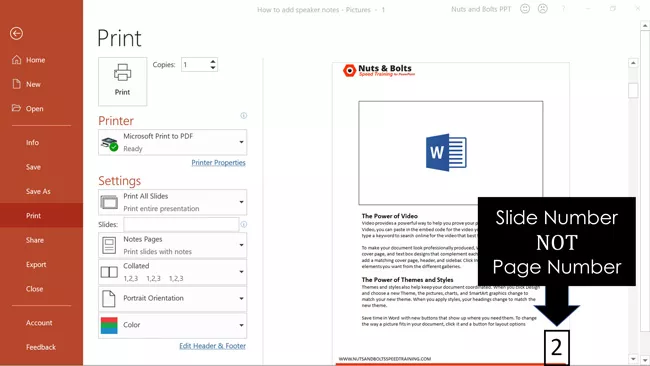
The number you see in the lower right-hand corner in the print preview are your slide numbers, not the actual page numbers. This can cause a lot of confusion when you are printing your slides with lots of notes, like when using your speaker notes as the client deliverable.
For example, in the picture below, notice that the number is the same on both pages. That is again because it is the slide number, not the page number. So, if you have five pages of notes for slide number 2, the number for all five pages of printing speaker notes will be 2.
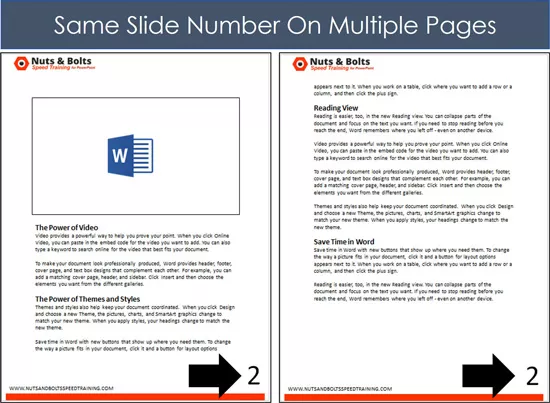
Slide numbers in PowerPoint are notoriously tricky to get right. They are much more difficult than managing page numbers in Microsoft Word. If you need help adding and managing your slide numbers in PowerPoint, read our guide here .
2. Slide thumbnails only display on the first page of notes
When printing speaker notes, the slide thumbnail only displays on the first page of your notes. So, if you have four pages of notes for a single slide, your thumbnail only displays on the first page (as pictured above).
3. Formatting your Notes Master for professional handouts
If you want your printed speaker notes to look professional, you will need to format your Notes Master. Notice in the picture below the difference in professionalism between formatted and non-formatting handouts.
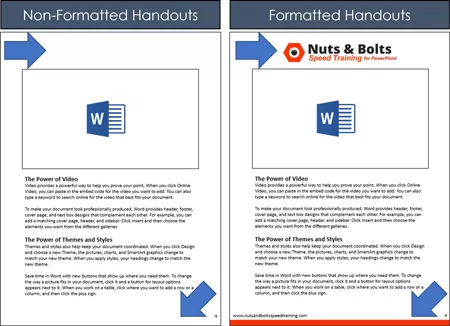
If your presentation is important, I highly recommend formatting your Notes Master with your company logo, website address, etc. That way when you print your slides as handouts, they will look sharp, clean, and professional.

To navigate to your Notes Master to format your handouts, simply:
- Click the Notes Master command.
You can add anything you like to your Notes Master just as you would add it to a PowerPoint slide. At a bare minimum, I recommend adding your company logo (as a PNG) and website address. If you are holding a training seminar, I also recommend adding your contact details too.
How to export your speaker notes to Microsoft Word
Another option for printing and editing your notes is to first push them to Microsoft Word.
This gives you the additional option to have your speaker notes on the right of your slides. On top of that, once in Word, you can format and edit your speaker notes in the full Microsoft Word editing environment.

To convert your speaker notes into Microsoft Word document, simply:
- Navigate to the File tab
- Click the Export command
- Select Create Handouts once
- Select Create Handouts a second time
- Pick either Notes next to slide or Notes below slide
Clicking okay, your slides and speaker notes are pushed to a new Microsoft Word document where you can edit them.
Special note when exporting to Microsoft Word. The Create Handouts dialog box gives you the option to Paste Link . In my experience this linking feature is unreliable and rarely works the way you’d expect it to. So, I do not recommend using it.
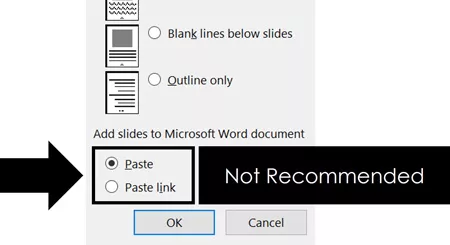
To expand your knowledge and learn how to convert Microsoft Word to PowerPoint, and some of the common pitfalls that can take place, read our guide here .
How long should your speaker notes be?
Although you can add as much information as you want to your notes, if you are using them as presentation prompts, I recommend keeping them short and punchy. Just enough to remind you of your next topic, or your key points.
Most people hate it if you stand up on stage and read your slides aloud, right? Well, the same is true if you stand on stage and read your speaker notes to them. This is the classic death by PowerPoint.
In addition, hiding behind your computer during your presentation creates an awkward relationship between you and your audience. So, if you are using your notes as speaking guides for your presentation, then use them sparingly. Instead of writing long sentences or paragraphs, try adding short prompts or highlights to jog your memory.
If you are looking for ideas on how to start your presentation with a bang, read our guide here .
If you need help ending your presentation on a high note, read our guide here .
Speaker notes in PowerPoint can be used in a variety of ways depending on what you are using PowerPoint for. Some use them as presentation prompts, others for research documentation, and others as the final client deliverable. Thankfully, PowerPoint gives you the flexibility to use your speaker notes any way you like.
Just remeber that the formatting of your notes appears differently in the different PowerPoint views.
If you enjoyed this article, you can learn more about our PowerPoint training courses and other useful resources here .
Related Articles
About the author.
Popular Tutorials
- How to Strikethrough Text (l̶i̶k̶e̶ ̶t̶h̶i̶s̶) in Word, Excel & PowerPoint
- How to Make Animated Fireworks in PowerPoint (Step-by-Step)
- Strikethrough Shortcut (l̶i̶k̶e̶ ̶t̶h̶i̶s̶) for Word, Excel & PowerPoint
- How to Create a Flash Card Memory Game in PowerPoint (Like Jeopardy)
- Keyboard Shortcuts Not Working: Solved
PowerPoint Tutorial Categories
- Strategies & Opinions
- Presentation Design
- Pictures, Icons, Videos, Etc.
- New Features
- Miscellaneous
- Charts & Data Viz
We help busy professionals save hours and gain peace of mind, with corporate workshops, self-paced courses and tutorials for PowerPoint and Word.
Work With Us
- Corporate Training
- Presentation & Template Design
- Courses & Downloads
- PowerPoint Articles
- Word Articles
- Productivity Resources
Find a Tutorial
- Free Training
- For Businesses
We help busy office workers save hours and gain peace of mind, with tips, training and tutorials for Microsoft PowerPoint and Word.
Master Critical PowerPoint Shortcuts – Secure Your FREE Training Module and Save Valuable Time!
⌛ Master time-saving expert techniques.
🔥 Create powerful presentations.
🚀 Propel your career to new heights.
We value your privacy – we keep your info safe.
Discover PowerPoint Hacks Loved by Industry Giants - KKR, AmEx, HSBC!
Over 114,880 professionals in finance, marketing and sales have revolutionized their PPT skills with our proven methods.
Gain FREE access to a full module of our premium PowerPoint training program – Get started today!
We hate spam too and promise to keep your information safe.
You are currently viewing a placeholder content from Facebook . To access the actual content, click the button below. Please note that doing so will share data with third-party providers.
- Link to facebook
- Link to linkedin
- Link to twitter
- Link to youtube
- Writing Tips
How to Add Speaker Notes in PowerPoint

4-minute read
- 31st January 2024
Adding speaker notes to your PowerPoint allows you to present with confidence while avoiding information overload in your slides. This means an engaged audience! But how do you add speaker notes? Read on for our simple step-by-step guide.
What Are Speaker Notes in PowerPoint?
There’s nothing worse than sitting through a PowerPoint presentation with slides so full of information that you miss what the speaker is saying while you try to read them. And as a presenter, you can come across as dull if you simply read the slides.
These problems can be avoided by having a separate set of prompts to keep you on track – speaker notes in PowerPoint are the on-screen version of those.
Just like hand-held notes, speaker notes in PowerPoint are visible to the speaker (hence the name), but not displayed in the slideshow.
You can also use speaker notes to jot down any issues that come up during a presentation. And if you need to ask someone else to help operate the PowerPoint, you can use speaker notes to add instructions so it all runs smoothly.
How to Add Speaker Notes to Your PowerPoint
To add speaker notes to your PowerPoint presentation, follow these steps.

1. Select the Relevant Slide
Click on the slide where you want to add the notes.
2. Click to Add Notes
To add your speaker notes to the slide, you have two options:
- You may see a prompt at the bottom of the screen that says, “Click to add notes.” Click in that section and type away!
- If you can’t see it, click Notes in the bottom ribbon to reveal it.
View Your Speaker Notes
If your notes are long, a scroll bar will appear at the side so you can navigate through them.
You can also increase the size of the notes section. Hover your cursor along the top of the section until it looks like a horizontal line with up and down arrows. Click and drag to change the size of the notes section.
Find this useful?
Subscribe to our newsletter and get writing tips from our editors straight to your inbox.
Edit Speaker Notes While Presenting Your PowerPoint
It always happens, however well you’ve prepared: someone will ask a question you weren’t expecting, or you’ll notice something you missed. Never fear! You can still edit your speaker notes while presenting your PowerPoint. It’s simple, and your audience don’t need to know. Here’s how.
1. Select Presenter View
This should start automatically when you connect to a projector and start your slideshow. If it doesn’t, then you can select it by clicking on Presenter View in the Slideshow tab on the ribbon.
2. Add Your Notes
The notes section is on the right of the current slide. This contains any speaker notes you’ve already added. You can add and delete notes in that section while presenting.
All your audience will see is the slideshow.
Finishing Up
Congratulations! Your speaker notes are now ready for you to present your PowerPoint. You can even print them for your audience to take away, leaving them free to enjoy your presentation. Simply click on Print in the File menu and then select Notes from the dropdown list in the print dialog box.
Adding speaker notes to your PowerPoint is a simple way to keep on track during your presentation and allow your audience to take in your slides.
Of course, you’ll also need to make sure that the other elements of your presentation are on point – you don’t want your hard work derailed by spelling and grammar issues. We can help with that! Our team of expert editors and proofreaders are available 24/7 to polish your PowerPoint presentation . And you can try it for free .
Share this article:
Post A New Comment
Got content that needs a quick turnaround? Let us polish your work. Explore our editorial business services.
9-minute read
How to Use Infographics to Boost Your Presentation
Is your content getting noticed? Capturing and maintaining an audience’s attention is a challenge when...
8-minute read
Why Interactive PDFs Are Better for Engagement
Are you looking to enhance engagement and captivate your audience through your professional documents? Interactive...
7-minute read
Seven Key Strategies for Voice Search Optimization
Voice search optimization is rapidly shaping the digital landscape, requiring content professionals to adapt their...
Five Creative Ways to Showcase Your Digital Portfolio
Are you a creative freelancer looking to make a lasting impression on potential clients or...
How to Ace Slack Messaging for Contractors and Freelancers
Effective professional communication is an important skill for contractors and freelancers navigating remote work environments....
3-minute read
How to Insert a Text Box in a Google Doc
Google Docs is a powerful collaborative tool, and mastering its features can significantly enhance your...

Make sure your writing is the best it can be with our expert English proofreading and editing.
- Stream Your Favorite Sports
- Where to Watch WNBA Games
How to Use Speaker Notes in PowerPoint
Speaker notes keep a presenter on track during a presentation
- Brock University
What to Know
- To add a note, go to Slide pane > select slide's thumbnail > enter notes into Notes pane.
- To see notes during presentation, go to Slide Show > Use Presenter View .
Here's how to use and print PowerPoint notes, accompanied thumbnail versions of the appropriate slides, as a handy reference when making an oral presentation. Instructions in this article apply to PowerPoint 2019, 2016, 2013, 2010; PowerPoint for Microsoft 365, PowerPoint for Mac, and PowerPoint Online.
How to Add Notes in PowerPoint
Keep on track during your slideshow by adding speaker notes to each slide of your presentation. You don't need to write down everything you want to say, just add enough information to keep your speech flowing.
Go to View and select Normal . In PowerPoint Online, toggle the notes pane on and off by selecting View > Notes .
In the Slide pane, select the thumbnail of the slide you want to add a note.
Place the cursor in the Notes pane. The text in the Notes pane reads, Click to add notes .
If you don't see the Notes pane, go to View and select Notes . On a Mac, drag the bar below the slide upward to reveal the notes section.
Type or paste your notes into the Notes pane.
Save the changes to your presentation.
How to See Your Notes During a Presentation
If your computer is connected to another monitor or projector, you can enable Presenter View in PowerPoint 2016, 2013, and 2010.
Go to Slide Show and select Use Presenter View .
Select the monitor that you want to use to view your speaker notes in the Display Settings dialog box. Place a check next to This is my main monitor .
If available, select From Current Slide , Custom Slide Show , Present Online , or Broadcast Slide Show . Each of these views displays your slideshow notes during the presentation.
PowerPoint for Mac works a little differently than the Windows version. To see your notes during a presentation, go to Slide Show and select Presenter View .
PowerPoint Online is unable to open a presentation in Presenter View because it can't connect to an additional monitor.
Tips and More Information on PowerPoint Notes
Speaker notes are notes added to PowerPoint presentation slides as a reference for the presenter . Notes in a PowerPoint slide are hidden during the presentation and only visible to the one presenting the slides.
Presenter View works only if your computer is connected to another display. The purpose of Presenter View is to show something different on your screen than on the one your viewers are watching.
While in Presenter View, you'll see the current slide, the upcoming slide, and your notes. Presenter View includes a timer and a clock that shows if your presentation is running too short or too long.
To exit Presenter View, and end the presentation, select End Slide Show at the top of the screen. If you don't see that option, right-click the slideshow and select End Show .
Get the Latest Tech News Delivered Every Day
- How to Hide and Unhide a Slide in PowerPoint
- Make the Most of PowerPoint's Slide Transition Options
- How to Print PowerPoint Slides
- Slide Layouts in PowerPoint
- Different Ways to View Slides in PowerPoint
- How to Add Page Numbers in PowerPoint
- Add, Delete or Change the Order of PowerPoint Slides
- How to Put a GIF in PowerPoint
- Outline View in PowerPoint or OpenOffice
- Loop a PowerPoint Slide Show
- How to Do a Voiceover on PowerPoint
- How to Share a PowerPoint on Zoom
- Tips for Memorial PowerPoint Presentations
- The 10 Most Common PowerPoint Terms
- Edit Music, Sound, or Other Audio Settings in PowerPoint
- How to Make a Slideshow on PowerPoint

A simple guide to slideshows
Learn what slideshows are, how they’re used, common features, and how to choose a slideshow maker. Get started creating your own slideshows today with Microsoft PowerPoint.
What is a slideshow?
What are slideshows used for.

Meetings and presentations
Slideshows are most frequently used to create professional presentations for business meetings, conferences, and educational purposes. A slideshow program allows people to organize content, include visuals, and enhance the overall impact of their message.

Visual storytelling
Because slideshows sequentially display engaging visuals, text, and other multimedia, they’re a strong way to tell a cohesive and compelling narrative from start to finish.

Content creation
Slideshows give content creators a versatile and efficient way to organize information, increase visual appeal, and communicate effectively across different contexts.

Photo and video sharing
Slideshow makers are popular for creating photo and video presentations, especially for events like weddings, birthdays, and vacations. People can add transitions, music, and captions to fully bring the photo-sharing experience to life.

Training and tutorials
Slideshows help break down complex information into digestible chunks with the support of visuals and text, making them ideal for instructional materials, tutorials, and training modules.

Collaborative projects
In collaborative settings, teams use slideshow makers to create joint presentations or reports. The best slideshow makers enable multiple contributors to add their content simultaneously, which helps ensure a cohesive and unified presentation.
What are the features of a slideshow creator?
Slideshow creators vary in what they offer but ideally include:
A library of templates, themes, and images.
If you’re not a designer, this feature is huge. Simply browse the options available in your slideshow maker library to create a polished, professionally designed presentation in a flash. Be sure to confirm that access to the library is free and the images are approved for unrestricted usage.
Audio and video compatibility.
Keeping your audience engaged is key to any successful slideshow presentation. To mix things up, being able to add a multimedia element—like a song or a video clip—will help people stay focused and interested.
Presentation tools.
Handy presenter tools go a long way toward making your slideshow experience seamless. For example, straightforward slide navigation, slideshow keyboard shortcuts, pen and highlighter markup, and adjustable resolution settings.
AI assistance.
With AI revolutionizing content creation, using a slideshow maker that has AI capabilities will enhance efficiency and innovation. Depending on the slideshow app you have, creating an entire slideshow could be as easy as a quick prompt, like “Make a presentation about the benefits of sustainable fashion that has 15 slides.”
Animations.
Like audio and video, animations give your audience a bit of sensory surprise that can capture their attention.
Slide transitions.
Add some pizzazz to how you change slides with visual effects like fading, wiping, and zooming.
Screen recording.
Being able to record your screen in a slideshow maker is helpful when giving an instructional talk, software demonstration, and other types of presentations that require visual aids.
A place to put speaker notes.
Having somewhere to jot a few notes down will help remind you of everything you want to cover as you present.
Different viewing options.
Looking at different views—for example, a presenter view, an audience view, and a high-level view of slide order—is useful when organizing your slideshow’s structure and understanding and preparing for what you’ll see versus what your audience will see.
How do I choose the right slideshow maker?
When choosing a slideshow maker, keep the following questions in mind to make sure you get the most for your money:
Is it scalable with your business?
As your organization grows and changes, it’s important to have flexible technology that adapts to new needs. Having certain features—such as cloud-based collaboration, compatibility with other work apps, and a mobile app—will help ensure that no matter how your business changes, the slideshow maker is up to the task. This also applies to pricing plans. Consider choosing a slideshow app that has a subscription plan (so the software is always up to date), volume-based pricing, or enterprise-level pricing.
Does it have a variety of visual elements?
It’s pretty much a given that a slideshow maker will allow you to add images, but think outside the JPEG box—what other visual elements are available to you? Features like preset themes, free templates, SmartArt, a built-in clip art library, shape tools, background styles, 3D models, and charts and graphs provide diverse ways to switch up how a slideshow looks without relying solely on adding your own images.
Is it easy to use?
You could have the most feature-rich slideshow maker on the market, but if it isn’t easy to use, you probably won’t use it. Or you will, but you’ll be frustrated, waste valuable time, and have difficulty convincing people you work with to use it. As you research slideshow makers, look for videos that show the apps’ interfaces in action to help you decide if they’re intuitive and will have a shorter learning curve.
Does it have collaboration and sharing options?
Because making a slideshow is often a collaborative effort, it’s worthwhile to find a slideshow creator that was designed with this in mind. Pick one that offers editing controls and commenting, as well as the ability to work on a slideshow at the same time as someone else. Having a cloud-based slideshow maker will be key here. You’ll not only save yourself time but also keep things simple by not having multiple versions of the same slideshow.
Explore more about slideshows and slideshow makers
Copilot in powerpoint.
Transform how you make slideshows with the versatile AI in Copilot for PowerPoint.
Improve your presenting skills
Practice presenting with an AI speaker coach to get feedback on body language, repetition, and pronunciation.
Six slideshow tips and tricks
Read up on tips about how to finesse your slideshows to give your most confident presentations.
Get free PowerPoint templates
Show your style with PowerPoint templates in more than 40 categories.
How to make a branded slideshow
Create a cohesive visual identity for your brand that goes beyond adding a logo to every slide.
Try a photo album template
Relive your favorite memories with photo album templates designed for all your unforgettable moments.
The benefits of visual aids in slideshows
Discover why using visual aids helps communicate ideas and messaging more effectively.
Slideshows that reach all learners
Explore the different ways that people learn and how to include all learning styles in your presentations.
Frequently asked questions
How do i make a good slideshow.
Making a good slideshow in PowerPoint is easy:
Plan what you’d like to include in your slideshow.
Launch your slideshow creator.
Choose the theme you’d like.
Import media.
Add text, music, and transitions.
Record, save, and share your slideshow.
Learn more about how to make a slideshow .
How do I add music to a slideshow?
To add music to a slideshow, first make sure that you’re using a slideshow maker with music compatibility. In PowerPoint, follow these steps:
Open your PowerPoint presentation and select the slide where you want to add music.
Click on the Insert tab in the ribbon menu.
Click on the Audio button and select Audio on My PC.
Browse to the folder on your computer where the audio file is located and select it.
Click on the Insert button.
How do I record a slideshow?
The steps for recording a slideshow in PowerPoint will vary depending on the version that you own. Get help with slideshow recording based on your version.
What types of files can I add to a slideshow?
File compatibility in PowerPoint includes the use of JPEGs, PNGs, TIFFs, GIFs, PDFs, MP3s, WAVs, MIDIs, MPEG-4 Videos, and Windows Media Videos.
How do I share my slideshow?
To share your PowerPoint slideshow, follow these steps:
Open your presentation and click Share at the top right of your screen.
If your presentation isn't already stored on OneDrive, select where to save your presentation to the cloud.
Choose a permission level, like Anyone with a link , or maybe just people in your company. You can also control if people can edit or just view the doc.
Select Apply.
Enter names and a message.
Select Send.
Follow Microsoft

Use a screen reader to read or add speaker notes and comments in PowerPoint
This article is for people who use a screen reader program such as Windows Narrator, JAWS, or NVDA with Microsoft 365 products. This article is part of the Microsoft 365 screen reader support content set where you can find more accessibility information on our apps. For general help, visit Microsoft Support .
Use PowerPoint with your keyboard and a screen reader to add and read speaker notes in your PowerPoint presentation. We've tested it with Narrator, JAWS, and NVDA, but it might work with other screen readers as long as they follow common accessibility standards and techniques. You'll learn how to use speaker notes to add reminders or talking points for the presenter, and use comments to give your colleagues feedback about their presentations.
New Microsoft 365 features are released gradually to Microsoft 365 subscribers, so your app might not have these features yet. To learn how you can get new features faster, join the Office Insider program .
To learn more about screen readers, go to How screen readers work with Microsoft 365 .
In this topic
Add speaker notes, read speaker notes, add a comment, read comments.
Add speaker notes in your presentation to tell a story to your audience beyond the slide content. You can use the speaker notes as private reminders of the slide content, too.
To display the Notes pane, in the Normal view, press Alt+W, P, N.
On the slide where you want to add notes, press F6 until you hear: "Slide notes."
Type your notes.
To exit the Notes pane, press F6.
You can hear whether a slide has notes and listen to the notes.
In the Normal view, press F6 until you hear: "Thumbnails."
Press the Up or Down arrow key until you hear the title or number of the slide and its position in the list of slides. If there are speaker notes on the slide, you hear: “Has notes.”
To display the Notes pane, press Alt+W, P, N.
Press F6 until you hear “Slide notes,” and then press the SR key+R to listen to the note.
You can add comments on slides if you're, for example, reviewing someone else's work.
If you want to comment on a specific piece of text or an object, select it first. To find out how to select in PowerPoint using keyboard shortcuts, refer to Use keyboard shortcuts to create PowerPoint presentations .
On a slide, in the Normal view, when you hear a piece of text or an object you want to comment on, press Alt+R, C. The Comments pane opens.
Type your comment and press Ctrl+Enter to save it.
To exit the Comments pane, press Esc.
To close the Comments pane, press Alt+R, P, P.
You can hear whether a slide has comments and listen to the comments.
In the Normal view, press F6 until you hear: "Thumbnails."
Press F6 and the Up or Down arrow key until you hear the title or number of the slide and its position in the list of slides. If there are comments on the slide, you hear: “Has comments.”
To open the Comments pane, press Alt+R, P, P. You hear: “Comments on slide.”
If the Comments pane is already open, press F6 or Shift+F6 until you hear: "Comments on slide."
Press the SR key+Right or Left arrow key to move through the comments. Your screen reader reads the comments as you land on them.
Use a screen reader to add and format text in PowerPoint
Use a screen reader to save your presentation in PowerPoint
Use a screen reader to show your presentation with PowerPoint
Use keyboard shortcuts to create PowerPoint presentations
Use keyboard shortcuts to deliver PowerPoint presentations
Basic tasks to create a presentation in PowerPoint with a screen reader
Set up your device to work with accessibility in Microsoft 365
Use a screen reader to explore and navigate PowerPoint
Use PowerPoint with your keyboard and VoiceOver, the built-in macOS screen reader, to add and read speaker notes and comments in your presentation.
This topic assumes that you are using the built-in macOS screen reader, VoiceOver. To learn more about using VoiceOver, go to VoiceOver Getting Started Guide .
Add comments
Reply to a comment, resolve comments.
Add speaker notes in your presentation to tell a story to your audience beyond the slide content. You can use the speaker notes as private reminders of the slide content, too. You can add the speaker notes in the Normal view if you're adding only short notes, or in the Notes Page view if you're planning to write more notes per slide.
Add speaker notes in the Normal view
On the slide where you want to add speaker notes, press Shift+F6 until you hear: "Notes pane."
Type your speaker notes for the slide.
Add speaker notes in the Notes Page view
On the slide where you want to add speaker notes, in the Normal view, press Command+3. You hear: "Notes page, checked."
In the Notes Page view, press the Tab key until you hear: "Entering slides notes text box, Edit text." Then type your speaker notes.
To move to the notes on another slide, in the Notes Page view, press Option+Control+Shift+Up arrow key until you hear: "Out of notes page view, layout area." Press Esc once, and then press Option+Right or Left arrow key until you hear the slide you want.
To return to the Normal view, press Command+1.
You can listen to the notes on your headset and then deliver them verbally to your audience, or let VoiceOver read the notes out loud. You can listen to the speaker notes either in the Normal view or the Notes Page view when you're creating or editing your presentation. When you're delivering a slide show, you can use the Presenter View .
Read speaker notes in the Normal view
On the slide, press Shift+F6 until you hear: "Notes pane."
In the Notes Pane , press Control+Command+Right arrow key. You hear "Edit text, insertion at beginning of text," followed by the speaker notes text.
Read speaker notes on a Notes Page view
On a slide, press Command+3. You hear: "Notes page, checked."
In the Notes Page view, press the Tab key until you hear "Edit text," followed by the speaker notes text.
Read speaker notes in the Presenter View
To switch to the Presenter View , on a slide in the Normal view, press Option+Return. You hear: "Now in PowerPoint presenter view."
In the Presenter View , press Control+Option+Left or Right arrow key until you hear: "Notes pane, layout area."
To read the notes text, in the Notes pane, press Control+Option+Shift+Down arrow key. VoiceOver reads the speaker notes text. To stop reading, press Control once.
You can add comments on slides if you're, for example, working together with others on a presentation or you're reviewing someone else's work.
On the slide where you want to add comments, press F6 until you hear the name of the current tab on the ribbon.
Press Control+Option+Left or Right arrow key until you hear "Review tab," and then press Control+Option+Spacebar.
On the Review tab, press the Tab key until you hear "New comment button," and then press Control+Option+Spacebar. The Comments pane opens, and the focus moves to the comment text field in the pane.
Type your comment.
To insert your comment, press Command+Return.
Reply to a comment
Open the Comments pane and read the comments as instructed in Read comments .
When on a comment you want to reply to, press Control+Option+Right arrow key until you hear "Reply, edit text," and then type your reply.
To insert your reply, press Command+Return.
When on a comment you want to resolve, press the Tab key until you hear "More thread actions button," and then press Control+Option+Spacebar.
To resolve the comment, press the Down arrow key until you hear "Resolve thread," and press Control+Option+Spacebar.
You can use VoiceOver to listen to others' comments and to check who's commented on your presentation and when.
In the Normal view, press F6 until you hear the current tab on the ribbon.
Press Control+Option+Left or Right arrow key until you hear "Review tab," and press Control+Option+Spacebar.
On the Review tab, press the Tab key until you hear: "Show comments menu button."
To open the Comments pane, press the Up or Down arrow key until you hear "Comments pane," and press Control+Option+Spacebar. If you hear "Check mark, Comments pane," the Comments pane is already open. In that case, press Esc and proceed to the next step.
On a slide, press F6 until you hear: "Comments, selected tab."
In the Comments pane, press the Tab key until you hear: "Entering comment thread." The focus is now on the first comment of the thread. To read the comment, press the Tab key. VoiceOver also announces the time when the comment was added and who wrote it.
To move to the next comment thread, press Option+Control+Shift+Up arrow key. You hear: "Out of comment thread." Then press the Down arrow key until you hear the next thread.
Use PowerPoint with VoiceOver, the built-in iOS screen reader, to add and read speaker notes and comments in your presentation.
This topic assumes that you are using the built-in iOS screen reader, VoiceOver. To learn more about using VoiceOver, visit Apple accessibility .
Resolve a comment
When you open a presentation in PowerPoint, it opens in the Normal view where VoiceOver can read the speaker notes.
To navigate to a slide that has speaker notes, swipe right until you hear the slide number and title, followed by "Has notes." Double-tap the screen to select the slide.
To open the Notes pane, swipe left until you hear "Notes button," and double-tap the screen.
The Notes pane opens. To read the notes, swipe left until you hear "Slide notes, text box," followed by the speaker notes for the slide.
To close the Notes pane, swipe left until you hear "Close, button," and double-tap the screen.
You can use speaker notes as private reminders of what to say when presenting your slides to the audience.
On the slide where you want to add speaker notes, swipe right until you hear: "Notes, button." Then double-tap the screen. The Notes pane opens.
Note: If you hear "Notes" instead of "Notes button," the Notes pane is already open.
To go to the notes text field, swipe right until you hear: "Slide notes, text box, text field."
Double-tap the screen, and then use the on-screen keyboard to type your notes.
To close the keyboard, swipe right until you hear "Hide keyboard," and then double-tap the screen.
Read comments
When you open a presentation in PowerPoint, it opens in the Normal view where VoiceOver can read the comments.
To navigate to a slide that has comments, swipe right until you hear the slide number and title, followed by "Has comments." Double-tap the screen to select the slide.
To open the comment pane, swipe left until you hear "Comments button," and double-tap the screen.
The comment pane opens. To read the comment, swipe left or right until you hear "Threaded comment," followed by the name of the person who wrote the root comment and the contents of the comment.
To read the replies to the root comment, swipe right until you hear "Reply," followed by the name of the person who wrote the reply and the contents of the reply.
To navigate to the next comment, swipe left until you hear "Next comment," and double-tap the screen. To return to the previous comment, swipe left until you hear "Previous comment," and double-tap the screen.
To close the comment pane, swipe left until you hear "Close the comment pane, button," and double-tap the screen.
On the slide where you want to add a comment, tap near the top of the screen with four fingers, swipe right until you hear "Show ribbon," and then double-tap the screen. You hear the name of the currently selected tab.
Double-tap the screen, swipe right or left until you hear "Insert tab," and double-tap the screen.
Swipe right until you hear "Insert a comment," and double-tap the screen. You hear: "At mention or comment." The focus is on the comment text field.
Use the on-screen keyboard to type your comment.
To insert your comment, swipe right until you hear "Post comment, button," and then double-tap the screen. The comment pane opens. You hear: "Close the comment pane."
To close the comment pane, double-tap the screen.
Open the comment pane and read the comments as instructed in Read comments .
When on a comment you want to reply to, swipe right until you hear "At mention or reply," and then double-tap the screen.
Use the on-screen keyboard to type your reply.
To insert your reply, swipe left until you hear "Post reply," and double-tap the screen.
When on a comment you want to resolve, swipe right until you hear "More thread actions," and then double-tap the screen.
To resolve the comment, swipe right until you hear "Resolve thread," and double-tap the screen.
Use a screen reader to work with slides in PowerPoint
Use PowerPoint for Android with TalkBack, the built-in Android screen reader, to add and read speaker notes or comments in a presentation. With speaker notes, you can add reminders or talking points for the presenter. With comments, you can give your colleagues feedback about their presentations.
This topic assumes that you are using the built-in Android screen reader, TalkBack. To learn more about using TalkBack, go to Android accessibility .
On the slide where you want to add speaker notes, swipe left or right until you hear: "Notes, switch." Then double-tap the screen. The Notes text field opens.
To go to the text field, swipe right until you hear "Slide notes," and then double-tap the screen.
Use the on-screen keyboard to type your notes.
To close the Notes text field when you're done, swipe down-then-left.
When you're browsing the list of slides in the Reading view, TalkBack tells you if the slide has notes. You hear the number and title of the slide, followed by "Has notes." To read the notes, you need to open the slide in the Editing view. When you're delivering a slide show, you can use the Presenter View to read your notes.
Read speaker notes in Editing view
In the Reading view, navigate to a slide that has speaker notes, and then double-tap the screen. You hear: "Edit button." Double-tap the screen. The slide opens in the Editing view.
Swipe left or right until you hear "Notes, switch," and then double-tap the screen.
The Notes text field opens. To read the notes, swipe right until you hear "Selected, Slide notes," followed by the speaker notes for the slide.
To close the Notes text field, swipe left until you hear "Close, button," and then double-tap the screen.
Read speaker notes while delivering a slide show
In the Reading or Editing view, swipe left or right until you hear "Present button," and then double-tap the screen. The landscape mode activates. Rotate your device to landscape mode.
Swipe right until you hear the slide you want, and then double-tap the screen.
To read the speaker notes, rotate your device to portrait mode, swipe right until you hear "Selected, Slide notes," followed by the speaker notes for the slide.
You can add comments on slides if you're, for example, working with others on a presentation or you're reviewing someone else's work.
On the slide content area where you want to add comments, double-tap the screen. The context sensitive menu opens. You hear: "Cut button."
Swipe right until you hear "New comment, button," and then double-tap the screen. The @mention or comment text field opens, and the focus moves to the beginning of the text field.
Use the on-screen keyboard to type your comments. When you're done, swipe down-then-left to close the on-screen keyboard.
To insert your comment, swipe right until you hear "Post comment," and then double-tap the screen. The comment pane opens. You hear: "Close the comment pane." To close the comment pane, double-tap the screen.
When you're browsing the list of slides in the Reading view, TalkBack tells you if the slide has comments. You hear the number and title of the slide, followed by "Has comments." To read the comments, you need to open the slide in the Editing view.
In the Reading view, navigate to a slide that has comments, and then double-tap the screen. You hear: "Edit button." Double-tap the screen. The slide opens in the Editing view.
Swipe left or right until you hear "Comments, switch," and then double-tap the screen.
The comment pane opens. To read the comments, swipe right until you hear "Comment thread," and double-tap the screen.
Swipe right until you hear "Threaded comment," followed by the name of the person who wrote the comment and the comment content.
To read the replies to the comment, swipe right until you hear "Reply," followed by the name of the person who wrote the reply and the reply content.
To navigate to the next comment thread, swipe right until TalkBack announces the number of the next slide, followed by "Threaded comment." To navigate to the previous comment thread, swipe left until you hear the number of the previous slide, followed by "Threaded comment."
To close the comment pane, swipe left until you hear "Close, button," and then double-tap the screen.
Navigate to and read the comments as instructed in Read comments .
When on a comment you want to reply to, swipe right until you hear "At mention or reply," and double-tap the screen.
Use the on-screen keyboard to type your reply. When done, swipe down-then-left to close the on-screen keyboard.
To insert your reply, swipe right until you hear "Post reply," and double-tap the screen.
When on a comment you want to resolve, swipe right until you hear "More thread actions button," and double-tap the screen.
To resolve the thread, swipe right until you hear "Resolve thread," and double-tap the screen.
Use a screen reader to insert and edit pictures and tables in PowerPoint
Use PowerPoint for the web with your keyboard and a screen reader to add and read speaker notes or comments in a presentation. We have tested it with Narrator in Microsoft Edge and JAWS and NVDA in Chrome, but it might work with other screen readers and web browsers as long as they follow common accessibility standards and techniques. You'll learn how to use speaker notes, to add reminders or talking points for the presenter, and use comments to give your colleagues feedback about their presentations.
If you use Narrator with the Windows 10 Fall Creators Update, you have to turn off scan mode in order to edit documents, spreadsheets, or presentations with Microsoft 365 for the web. For more information, refer to Turn off virtual or browse mode in screen readers in Windows 10 Fall Creators Update .
When you use PowerPoint for the web, we recommend that you use Microsoft Edge as your web browser. Because PowerPoint for the web runs in your web browser, the keyboard shortcuts are different from those in the desktop program. For example, you’ll use Ctrl+F6 instead of F6 for jumping in and out of the commands. Also, common shortcuts like F1 (Help) and Ctrl+O (Open) apply to the web browser – not PowerPoint for the web.
To display the Notes pane, in the Normal view, press Alt+Windows logo key, W, P, N.
On the slide where you want to add notes, press Ctrl+F6 until you hear: "Slide notes."
To exit the Notes pane, press Ctrl+F6.
In the Normal view, press Ctrl+F6 until you hear the number of a slide and its position in the list of slides.
Press the Up or Down arrow key to browse through the list of slides. If there are speaker notes on the slide, you hear: “Has notes.”
To display the Notes pane, press Alt+Windows logo key, W, P, N.
Press Ctrl+F6 until you hear “Slide notes,” and then press the SR key+R to listen to the note.
On a slide, in the Normal view, when you hear a piece of text or an object you want to comment on, press Alt+Windows logo key, R, C, 1. The Comments pane opens. You hear: "@mention or comment, edit."
Type your comment. You can press Enter to start a new line.
To save the comment, press the Tab key until you hear "Post," and then press Enter.
To exit the Comments pane, press Ctrl+F6.
To close the Comments pane, press Alt+Windows logo key, R, P, P.
Press the Up or Down arrow key to browse through the list of slides. If there are speaker notes on the slide, you hear: “Has comments.”
To open the Comments pane, press Alt+Windows logo key, R, P, P. You hear: “Comments pane.”
If the Comments pane is already open, press Ctrl+F6 or Ctrl+Shift+F6 until you hear: "Comments pane."
Press the Tab key until you hear: "Comment card." Use the Up and Down arrow keys to move between comment cards, and the Left and Right arrow keys to move through the comments within each card. Your screen reader reads the comments as you land on them.
Technical support for customers with disabilities
Microsoft wants to provide the best possible experience for all our customers. If you have a disability or questions related to accessibility, please contact the Microsoft Disability Answer Desk for technical assistance. The Disability Answer Desk support team is trained in using many popular assistive technologies and can offer assistance in English, Spanish, French, and American Sign Language. Please go to the Microsoft Disability Answer Desk site to find out the contact details for your region.
If you are a government, commercial, or enterprise user, please contact the enterprise Disability Answer Desk .

Need more help?
Want more options.
Explore subscription benefits, browse training courses, learn how to secure your device, and more.

Microsoft 365 subscription benefits

Microsoft 365 training

Microsoft security

Accessibility center
Communities help you ask and answer questions, give feedback, and hear from experts with rich knowledge.

Ask the Microsoft Community

Microsoft Tech Community

Windows Insiders
Microsoft 365 Insiders
Find solutions to common problems or get help from a support agent.

Online support
Was this information helpful?
Thank you for your feedback.

IMAGES
VIDEO
COMMENTS
Add notes while creating your presentation. The Notes pane is a box that appears below each slide. (It is outlined in magenta in the picture below.) An empty Notes pane will prompt you with text that says, Click to add notes. Type your speaker notes there. If you don't see the Notes pane or it is completely minimized, click Notes on the task ...
Next, in the pane on left, select the slide where you'd like to add speaker notes. Next, click the "Notes" button at the bottom of the window. A small box reading "Tap to Add Notes" will appear beneath the slide. For Mac users, this will say "Click to Add Notes.". Now, simply type the speaker notes for that slide.
Select a slide you want to add notes to. View the Notes pane located beneath each slide. If it's not visible, you can make it appear by clicking Notes on the bottom taskbar. You will see a blank space with the prompt "Click to add notes." That's where you can enter your speaker notes.
When you're creating a presentation in PowerPoint, you can add speaker notes to refer to later while delivering the slide show in front of an audience. Learn...
Switch to Presenter View to Use Your Notes. A PPT with speaker notes really shines when you use Presenter View. To open Presenter View click on the Slide Show option in the ribbon. Then click on the Presenter View icon. This works anytime you're connected to a second display, like a monitor or projector.
Speaker notes in PowerPoint help presenters recall important points, such as key messages or stats, as they give a presentation. The speaker note panel lives at the bottom of your screen in Normal view, although some users may have this section hidden. Use the speaker notes to add more nuanced information about a slide's graphics, or ...
To see the full course that this video came from, go here: ️https://www.simonsezit.com/courses/microsoft/powerpoint-2021-online-course/In this Microsoft Pow...
Click the Notes button in the Status Bar at the bottom. Move your cursor to the bottom of the window. When you see the two-sided arrow, drag up until the panel displays. Step 3: When the panel is ...
In this video, you will learn how to add speaker notes to your Powerpoint presentations.Speaker Notes in PowerPoint is one of the many user-friendly tools ad...
On the View tab of the ribbon, in the Show group, select Notes. The pane appears across the bottom portion of the PowerPoint window, with the cursor blinking, ready for you to begin typing. Also, you can add speaker notes in PowerPoint by clicking the Notes option at the bottom of the slide to open the notes pane.
Adding Speaker Notes. Open your presentation in PowerPoint. At the bottom of the screen there's a text field with the message "Click to add notes". The text that you enter here will be visible for you during your presentation, but not for your audience. Adding speaker notes. If you can't see this text field, click View → Notes.
To add speaker notes to individual slides, follow these steps: Open Microsoft PowerPoint. From the Start screen, select Open Other Presentation, or select a presentation from the Recent list. Ensure that Slide 1 is currently displayed. This is generally your opening title slide.
Use Notes while you present. In Presenter View, your Notes for each slide appear under the Next slide. Scroll to view all of them if necessary. Use the Make the text larger or Make the text smaller buttons to change the size of the Notes.
To add or edit your speaker notes using the Notes Page view in PowerPoint, simply: Navigate to the View tab. Select the Notes Page view. Click into the input box to type or edit your notes. Note: If you type a lot of text in this view, your notes will run off the bottom of the page.
To add speaker notes to your PowerPoint presentation, follow these steps. 1. Select the Relevant Slide. Click on the slide where you want to add the notes. 2. Click to Add Notes. To add your speaker notes to the slide, you have two options: You may see a prompt at the bottom of the screen that says, "Click to add notes.". Click in that ...
In PowerPoint Online, toggle the notes pane on and off by selecting View > Notes . In the Slide pane, select the thumbnail of the slide you want to add a note. Place the cursor in the Notes pane. The text in the Notes pane reads, Click to add notes . If you don't see the Notes pane, go to View and select Notes.
In this video I will show you how to add speaker notes or presenter notes to your Microsoft Powerpoint presentation. You will learn how to click the speaker...
To add Speaker Notes to a presentation, start off by working in Normal view on PowerPoint's View tab. At the bottom of your screen, you can click on Notes to open up the Speaker Notes section and add your own text. ... As you learn how to put PowerPoint in presentation mode, you'll see how all these benefit you. ...
In PowerPoint, follow these steps: Open your PowerPoint presentation and select the slide where you want to add music. Click on the Insert tab in the ribbon menu. Click on the Audio button and select Audio on My PC. Browse to the folder on your computer where the audio file is located and select it. Click on the Insert button.
Keep the text to a minimum and put the extra stuff in the speaker notes section, out of your audience's sight. Then, refer to your notes while you give the presentation. Open the notes pane by clicking NOTES at the bottom of the window. Click in the notes pane below the slide, and enter your notes.
To open the Comments pane, press Alt+R, P, P. You hear: "Comments on slide.". If the Comments pane is already open, press F6 or Shift+F6 until you hear: "Comments on slide." Press the SR key+Right or Left arrow key to move through the comments. Your screen reader reads the comments as you land on them.